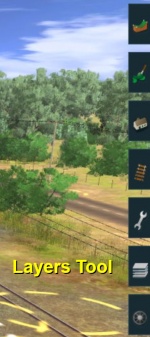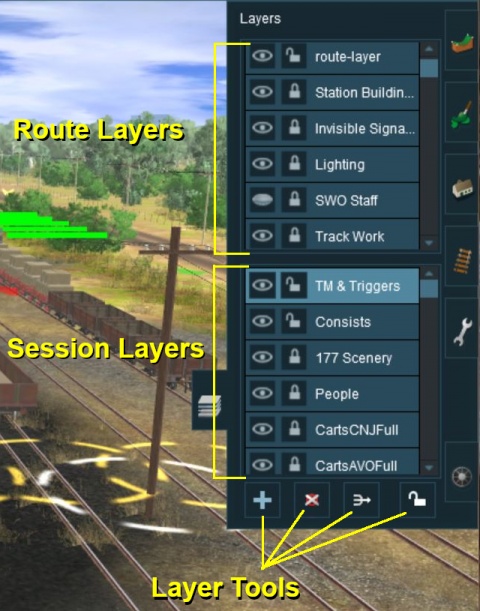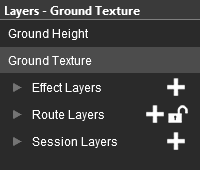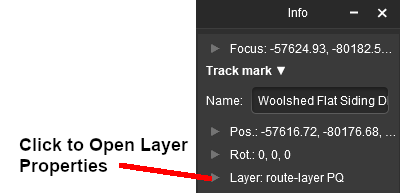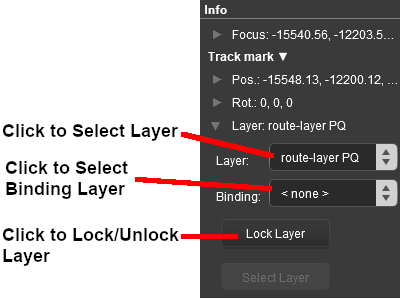How to Use Track Markers
m |
(added S20 instructions) |
||
| Line 1: | Line 1: | ||
| − | The information in this Wiki Page applies to '''TANE''', '''TRS19''', '''Trainz Plus''' and '''TRS22'''. | + | The information in this Wiki Page applies to '''TANE''', '''TRS19''', '''Trainz Plus''' (in '''Surveyor Classic''' mode) and '''TRS22'''. |
<table> | <table> | ||
<tr valign="top"> | <tr valign="top"> | ||
| Line 5: | Line 5: | ||
__TOC__ | __TOC__ | ||
</td> | </td> | ||
| − | <td | + | <td> |
<table cellpadding=4 bgcolor=#c1e7e7> | <table cellpadding=4 bgcolor=#c1e7e7> | ||
<tr valign="top"> | <tr valign="top"> | ||
| − | <td colspan=2><span style="font-size: 17px | + | <td colspan=2><span style="font-size: 17px;"><b>In Summary:</b></span></td> |
</tr> | </tr> | ||
<tr valign="top"> | <tr valign="top"> | ||
<td>[[file:DotPoint.JPG|link=]]</td> | <td>[[file:DotPoint.JPG|link=]]</td> | ||
| − | <td>''' | + | <td>'''Layers are a ''Surveyor'' tool that allows you to better manage the objects that are placed in your Trainz World.'''<td> |
</tr> | </tr> | ||
<tr valign="top"> | <tr valign="top"> | ||
<td>[[file:DotPoint.JPG|link=]]</td> | <td>[[file:DotPoint.JPG|link=]]</td> | ||
| − | <td>''' | + | <td>'''Layers are a ''Driver'' tool that allows you to change what the players see as they drive around your Trainz World.'''<td> |
| + | </tr> | ||
| + | </table> | ||
| + | <br> | ||
| + | <span style="font-weight: 700; Font-size: 15px;">Some Helpful Tips</span><br> | ||
| + | <table bgcolor="black" width=600> | ||
| + | <tr> | ||
| + | <td> | ||
| + | <table bgcolor="white" width=596> | ||
| + | <tr> | ||
| + | <td bgcolor="black" colspan=2> | ||
| + | <span style="font-size: 17px; color: white; font-weight: 700;"> Route Layers </span></td> | ||
</tr> | </tr> | ||
<tr valign="top"> | <tr valign="top"> | ||
| − | <td>[[ | + | <td>[[image:DotPoint.JPG|link=]]</td> |
| − | <td>''' | + | <td>'''Use Route layers for all those objects that will appear in every Session based on the Route'''</td> |
</tr> | </tr> | ||
<tr valign="top"> | <tr valign="top"> | ||
| − | <td>[[ | + | <td>[[image:DotPoint.JPG|link=]]</td> |
| − | <td> | + | <td>'''When you edit Route layers, <u>always</u> save the Route'''</td> |
</tr> | </tr> | ||
</table> | </table> | ||
| Line 31: | Line 42: | ||
</table> | </table> | ||
<br> | <br> | ||
| + | <table bgcolor="black" width=600> | ||
| + | <tr> | ||
| + | <td> | ||
| + | <table bgcolor="white" width=596> | ||
| + | <tr> | ||
| + | <td bgcolor="black" colspan=2> | ||
| + | <span style="font-size: 17px; color: white; font-weight: 700;"> Session Layers </span></td> | ||
| + | </tr> | ||
| + | <tr valign="top"> | ||
| + | <td>[[image:DotPoint.JPG|link=]]</td> | ||
| + | <td>'''Use Session layers for all those objects that will ONLY appear in the current Session'''</td> | ||
| + | </tr> | ||
| + | <tr valign="top"> | ||
| + | <td>[[image:DotPoint.JPG|link=]]</td> | ||
| + | <td>'''When you edit Session layers, <u>always</u> save the Session'''</td> | ||
| + | </tr> | ||
| + | <tr valign="top"> | ||
| + | <td>[[image:DotPoint.JPG|link=]]</td> | ||
| + | <td>'''Avoid using <span style="font-size: 15px;">"Default"</span> as the Session name'''</td> | ||
| + | </tr> | ||
| + | </table> | ||
| + | </td> | ||
| + | </tr> | ||
| + | </table> | ||
| + | <br> | ||
| + | <table bgcolor="black" width=600> | ||
| + | <tr> | ||
| + | <td> | ||
| + | <table bgcolor="white" width=596> | ||
| + | <tr> | ||
| + | <td bgcolor="black" colspan=2> | ||
| + | <span style="font-size: 17px; color: white; font-weight: 700;"> When Editing Layers </span></td> | ||
| + | </tr> | ||
| + | <tr valign="top"> | ||
| + | <td>[[image:DotPoint.JPG|link=]]</td> | ||
| + | <td>'''Lock the layers that you are not currently editing'''</td> | ||
| + | </tr> | ||
| + | <tr valign="top"> | ||
| + | <td>[[image:DotPoint.JPG|link=]]</td> | ||
| + | <td>'''Never add track objects (signals, switches, etc) to a layer that is higher up the layer list than the track layer'''</td> | ||
| + | </tr> | ||
| + | </table> | ||
| + | </td> | ||
| + | </tr> | ||
| + | </table> | ||
| + | </td> | ||
| + | </tr> | ||
| + | </table> | ||
| + | |||
<table> <!-- BEGIN Nav Buttons Table --> | <table> <!-- BEGIN Nav Buttons Table --> | ||
<tr valign="top"> | <tr valign="top"> | ||
| Line 36: | Line 96: | ||
<td width=46>[[file:BackToTop.png|link=#top|alt=Top|Top]]</td> | <td width=46>[[file:BackToTop.png|link=#top|alt=Top|Top]]</td> | ||
<td width=75> </td> | <td width=75> </td> | ||
| − | <td width=75>[[file:NextDown.png|link=# | + | <td width=75>[[file:NextDown.png|link=#stepToolS10|alt=Next Down|Next Down]]</td> |
<td width=75>[[file:BackToBottom.png|link=#bottom|alt=Bottom|Bottom]]</td> | <td width=75>[[file:BackToBottom.png|link=#bottom|alt=Bottom|Bottom]]</td> | ||
</tr> | </tr> | ||
</table> <!-- END Nav Buttons Table --> | </table> <!-- END Nav Buttons Table --> | ||
| − | |||
| − | + | ='''What Are Layers?'''= | |
| + | <br> | ||
| + | Layers can contain any objects, visible and invisible, that can be placed into a layout using the Surveyor '''Object''', '''Track''' and '''Train''' tools. The layers and their contents can be hidden from view or locked against alteration whenever required. Their main use is in the development of a Route and a Session but they can also be used as a way of providing some additional novelty during a Driver session. | ||
| − | <table> | + | <table bgcolor=#ffffb0 cellpadding=2> |
<tr valign="top"> | <tr valign="top"> | ||
| − | <td | + | <td>[[image:NotePad.PNG|link=]]</td> |
| + | <td><span style="font-size: 17px; font-weight: 700;">Effect Layers Notes:'''</span><br> | ||
| + | ---- | ||
| + | The special ground effects layers, '''Clutter''', '''TurfFX''' and more recently '''Water''', are not discussed here. They are more like '''Textures''' than '''Layers''' but some aspects of their use and operations are similar to the layers covered here. These special ground effects layers are saved as part of a '''Route''' but are not associated with any '''Route Layer'''. | ||
| + | </td> | ||
</tr> | </tr> | ||
| + | </table> | ||
| + | |||
| + | <table> <!-- BEGIN Nav Buttons Table --> | ||
<tr valign="top"> | <tr valign="top"> | ||
| − | <td>[[ | + | <td width=729><span id="stepToolS10"></span> </td> |
| − | <td> | + | <td width=46>[[file:BackToTop.png|link=#top|alt=Top|Top]]</td> |
| + | <td width=75>[[file:NextUp.png|link=#stepWhat|alt=Next Up|Top]]</td> | ||
| + | <td width=75>[[file:NextDown.png|link=#stepToolS20|alt=Next Down|Next Down]]</td> | ||
| + | <td width=75>[[file:BackToBottom.png|link=#bottom|alt=Bottom|Bottom]]</td> | ||
</tr> | </tr> | ||
| + | </table> <!-- END Nav Buttons Table --> | ||
| + | |||
| + | ='''The Layers Tool in Surveyor Classic (S10)'''= | ||
| + | |||
| + | <table> | ||
<tr valign="top"> | <tr valign="top"> | ||
| − | <td>[[ | + | <td>[[file:SurveyorToolMenuLayers.JPG|150px]]</td> |
| − | <td>''' | + | <td><br><br><br><br><br><br><br><br><br><br><br><br><br>[[file:RightArrowRed.JPG|link=]] |
| − | </ | + | <td>Click the '''Layers Tool''' (or press <span style="font-weight: 700; font-size: 17px; color: white; background-color: black;"> F6 </span>) to open up its properties.<br> |
| + | [[file:LayersTools.JPG|480px]]</td> | ||
| + | <td> | ||
| + | <br> | ||
| + | |||
| + | <table bgcolor=#000000 cellpadding=2> | ||
<tr valign="top"> | <tr valign="top"> | ||
| − | < | + | <td> |
| − | < | + | <table bgcolor=#ffffb0 cellpadding=2> |
<tr valign="top"> | <tr valign="top"> | ||
| − | <td>[[ | + | <td>[[file:NotePad.PNG|link=]]</td> |
| − | <td> | + | <td><span style="font-size: 17px;">'''Notes:'''</span><br> |
| + | ---- | ||
| + | The layers are organised into two groups:- | ||
| + | *'''Route Layers''' in the top group, and | ||
| + | *'''Session Layers''' in the lower group. | ||
| + | Each group can contain multiple layers - the scroll bars next to the layer names shown on the left indicate that there are more layers in each group than can fit into the display window area.</td> | ||
</tr> | </tr> | ||
| − | < | + | </table> |
| − | <td> | + | </td> |
| − | < | + | </tr> |
| + | </table> | ||
| + | </td> | ||
</tr> | </tr> | ||
</table> | </table> | ||
<br> | <br> | ||
| − | |||
| − | <table cellpadding=4 bgcolor=#c1e7e7> | + | ==Loading a Route and Loading a Session== |
| + | <table cellpadding=4 bgcolor=#c1e7e7 width="730"> <!-- BEGIN top level --> | ||
| + | <tr valign="top"> | ||
| + | <td colspan=2><span style="font-size: 17px;"><b>In Summary:</b></span></td> | ||
| + | </tr> | ||
<tr valign="top"> | <tr valign="top"> | ||
<td>[[file:DotPoint.JPG|link=]]</td> | <td>[[file:DotPoint.JPG|link=]]</td> | ||
| − | <td>''' | + | <td>'''Route Layers are saved with the Route. Session Layers are saved with the Session.<td> |
</tr> | </tr> | ||
| − | </table> | + | <tr valign="top"> |
| + | <td>[[file:DotPoint.JPG|link=]]</td> | ||
| + | <td>'''If you edit a Session Layer and later load just the Route then those edits will not appear.'''</td> | ||
| + | </tr> | ||
| + | </table> <!-- END top level --> | ||
<br> | <br> | ||
| − | <table | + | <table cellpadding=4 bgcolor="Aquamarine"> <!-- BEGIN Trainz Wiki Link --> |
<tr valign="top"> | <tr valign="top"> | ||
| + | <td>[[image:LinkWiki.PNG|link=]]</td> | ||
<td> | <td> | ||
| − | <table | + | More information on creating, loading and saving '''Routes''' and '''Sessions''' can be found on the '''Trainz Wiki Page''' at '''[[Route_and_Session_Basics|Route and Session Basics]]''' |
| + | </td> | ||
| + | </tr> | ||
| + | </table> <!-- END Trainz Wiki Link --> | ||
| + | <br> | ||
| + | The layers you see will depend on whether you have loaded a '''Route''' by itself (with no "child" Session) or a '''Session''' and its "parent" Route. | ||
| + | |||
| + | <table> <!-- BEGIN top level --> | ||
<tr valign="top"> | <tr valign="top"> | ||
| − | <td>[[file: | + | <td>[[file:LayersToolsRoute.JPG|link=]]</td> |
| − | <td> | + | <td>[[file:LayersToolsSession.JPG|link=]]</td> |
| − | ---- | + | <td>The first image on the left gives an example of the layers that can appear if a '''Route only''' is loaded into Surveyor. These are the layers that are saved with the Route. '''Note that a default "session-layer" is present'''. |
| − | + | <table cellpadding=4 bgcolor=#c1e7e7> <!-- BEGIN 2nd level --> | |
<tr valign="top"> | <tr valign="top"> | ||
| − | <td | + | <td>[[file:DotPoint.JPG|link=]]</td> |
| − | <td> | + | <td>'''An empty default "session-layer" is always created in the Session Layers Group when only the Route is loaded into Surveyor.'''</td> |
| + | </tr> | ||
| + | <tr valign="top"> | ||
| + | <td>[[file:DotPoint.JPG|link=]]</td> | ||
| + | <td>'''If you load just the Route and edit its "session-layer" then those edits will not appear the next time you load just the Route''' because an empty "session-layer" is created each time a Route is loaded without a Session. | ||
</td> | </td> | ||
</tr> | </tr> | ||
| + | </table> <!-- END 2nd level --> | ||
| + | The second image on the left gives an example of the layers that can appear if a '''Session based on that Route''' is loaded into Surveyor. It shows Route Layers and Session Layers.<br><br> | ||
| + | |||
| + | In both cases, the '''Route Layers''' are identical because the same Route has been loaded. A Session contains its own layers, the '''Session Layers''', that are loaded and saved with the Session but are not loaded or saved with the Route.<br> | ||
| + | |||
| + | <table bgcolor=#000000> <!-- BEGIN 2nd level Black Border --> | ||
<tr valign="top"> | <tr valign="top"> | ||
| − | <td | + | <td> |
| − | <td> | + | <table bgcolor=#ffffe0> <!-- BEGIN 2nd level Tip --> |
| + | <tr valign="top"> | ||
| + | <td>[[file:PencilTips.PNG|link=]]</td> | ||
| + | <td>If you load a '''Session''' and do not want to edit any of the '''Route layers''' then click the '''Lock Route Layers''' icon on the Layers Tool | ||
| + | <table> <!-- BEGIN 3rd level --> | ||
| + | <tr> | ||
| + | <td>[[file:LayersToolButtonsLOCKALL.JPG|link=]]</td> | ||
| + | <td>Click the '''Lock Button''' | ||
</td> | </td> | ||
</tr> | </tr> | ||
| − | </table> | + | </table> <!-- END 3rd level --> |
</td> | </td> | ||
</tr> | </tr> | ||
| − | </table> | + | </table> <!-- END 2nd level Tip--> |
</td> | </td> | ||
</tr> | </tr> | ||
</table> | </table> | ||
| + | <br> <!-- END 2nd level Black Border --> | ||
| + | </td> | ||
| + | </tr> | ||
| + | </table> <!-- END top level --> | ||
<br> | <br> | ||
| − | <table | + | <table bgcolor="red" cellpadding=2> |
<tr valign="top"> | <tr valign="top"> | ||
| − | <td>[[file: | + | <td> |
| − | <td> | + | <table bgcolor=#fcbcbc cellpadding=2> |
| − | + | <tr valign="top"> | |
| + | <td>[[file:Stop.PNG|link=]]</td> | ||
| + | <td><span style="font-size: 17px; font-weight: 700;">If you load a <span style="text-decoration: underline;">ROUTE</span> but not the SESSION then only <span style="text-decoration: underline;">edit the Route Layers</span></span></td> | ||
| + | </tr> | ||
| + | <tr valign="top"> | ||
| + | <td>[[file:Stop.PNG|link=]]</td> | ||
| + | <td><span style="font-size: 17px;">'''If you edit a <span style="text-decoration: underline;">SESSION</span> or its layers then always <span style="text-decoration: underline;">save the Session</span>'''</span></td> | ||
| + | </tr> | ||
| + | <tr valign="top"> | ||
| + | <td>[[file:Stop.PNG|link=]]</td> | ||
| + | <td><span style="font-size: 17px;">'''When you save a new <span style="text-decoration: underline;">SESSION</span> always give it a name, do <span style="text-decoration: underline;">NOT</span> leave it as "Default"</span> | ||
</td> | </td> | ||
</tr> | </tr> | ||
</table> | </table> | ||
| − | + | </td> | |
| − | + | ||
| − | + | ||
| − | + | ||
| − | + | ||
| − | + | ||
| − | + | ||
| − | + | ||
</tr> | </tr> | ||
| − | </table | + | </table> |
| − | = | + | ==Creating a New Route== |
| − | <table | + | <table> |
<tr valign="top"> | <tr valign="top"> | ||
| + | <td>[[file:LayersNewRoute.JPG|link=]]</td> | ||
<td> | <td> | ||
| − | <table bgcolor=#ffffb0 width= | + | <table> |
| + | <tr valign="top"> | ||
| + | <td>[[file:LayersNewRoute.JPG|link=]]</td> | ||
| + | <td> | ||
| + | <table bgcolor=#000000 width=604> | ||
| + | <tr valign="top"> | ||
| + | <td> | ||
| + | <table bgcolor=#ffffb0 width=600> | ||
<tr valign="top"> | <tr valign="top"> | ||
<td>[[file:NotePad.PNG|link=]]</td> | <td>[[file:NotePad.PNG|link=]]</td> | ||
| − | <td><span style="font-size: 17px | + | <td><span style="font-size: 17px;">'''Notes:'''</span><br> |
---- | ---- | ||
| − | + | *When a brand new route is created it will come with two layers, a single '''route-layer''' and a single '''session-layer'''. | |
| − | * | + | *Both layers will be empty (the baseboard with its grid is saved with the route but is not in any layer). |
| − | + | </td> | |
</tr> | </tr> | ||
| − | <tr valign="top" bgcolor=#ffffe0> | + | <tr valign="top"> |
| − | <td>[[ | + | <td colspan=2> |
| − | <td> | + | <table width=600 bgcolor=#ffffe0> |
| + | <tr valign="top"> | ||
| + | <td>[[file:PencilTips.PNG|link=]]</td> | ||
| + | <td>'''A layer can be renamed at anytime by double clicking on its name with the left mouse button and typing a new name''' | ||
| + | </td> | ||
</tr> | </tr> | ||
</table> | </table> | ||
| Line 146: | Line 285: | ||
</tr> | </tr> | ||
</table> | </table> | ||
| + | </td> | ||
| + | </tr> | ||
| + | </table> | ||
| + | </td> | ||
| + | </tr> | ||
| + | </table> | ||
| + | </td> | ||
| + | </tr> | ||
| + | </table> | ||
| + | |||
| + | ==The "Active Layer"== | ||
| + | |||
| + | <table cellpadding=4 bgcolor=#c1e7e7> | ||
| + | <tr valign="top"> | ||
| + | <td colspan=2><span style="font-size: 17px;"><b>In Summary:</b></span></td> | ||
| + | </tr> | ||
| + | <tr valign="top"> | ||
| + | <td>[[file:DotPoint.JPG|link=]]</td> | ||
| + | <td>'''The ''Active Layer'' is the selected (highlighted) layer.'''</td> | ||
| + | </tr> | ||
| + | <tr valign="top"> | ||
| + | <td>[[file:DotPoint.JPG|link=]]</td> | ||
| + | <td>When you load the '''Route only''' into Surveyor, the '''first Route layer''' will be the '''Active Layer'''</td> | ||
| + | </tr> | ||
| + | <tr valign="top"> | ||
| + | <td>[[file:DotPoint.JPG|link=]]</td> | ||
| + | <td>When you load a '''Session''' into Surveyor, the '''first Session layer''' will be the '''Active Layer'''</td> | ||
| + | </tr> | ||
| + | </table> | ||
| + | In the image above, the '''route-layer''' is the '''Active Layer'''. You can change the '''Active Layer''' at any time by clicking on the name of another layer. | ||
<br> | <br> | ||
| − | |||
| − | < | + | <table width=900> |
| − | <table> | + | <tr valign="top"> |
| + | <td width=484> | ||
| + | <table bgcolor=#000000 width=464> | ||
<tr valign="top"> | <tr valign="top"> | ||
| − | |||
<td> | <td> | ||
| − | <table | + | <table bgcolor=#ffffb0 width=460> |
| − | + | ||
| − | + | ||
| − | + | ||
| − | + | ||
<tr valign="top"> | <tr valign="top"> | ||
| − | <td>[[file: | + | <td>[[file:NotePad.PNG|link=]]</td> |
| − | <td><span style="font-size: 17px | + | <td><span style="font-size: 17px;">'''Notes:'''</span><br> |
| − | + | ---- | |
| − | + | The '''Active Layer''' is the "working layer" which is:- | |
| − | + | *where new objects will be added to the layout | |
| − | + | *the layer that is automatically selected for merging and deleting | |
| − | + | ||
| − | + | ||
</td> | </td> | ||
| − | |||
| − | |||
| − | |||
| − | |||
</tr> | </tr> | ||
</table> | </table> | ||
| − | + | </td> | |
| − | + | ||
| − | + | ||
</tr> | </tr> | ||
</table> | </table> | ||
| − | < | + | </td> |
| − | <table bgcolor= | + | <td width=12> </td> |
| + | <td width=484> | ||
| + | <table bgcolor="red" width=464> | ||
<tr valign="top"> | <tr valign="top"> | ||
<td> | <td> | ||
| − | <table bgcolor=# | + | <table bgcolor=#fcbcbc width=460> |
<tr valign="top"> | <tr valign="top"> | ||
| − | <td>[[file: | + | <td>[[file:Stop.PNG|link=]]</td> |
| − | <td> | + | <td>'''Trainz''' does not identify which is the '''Active Layer''' in '''Surveyor''' and this often leads to problems such as objects being added to the wrong layer.<br> |
| + | See [[file:PageLink.PNG|link=]] '''[[#Adding Objects To Layers|Adding Objects To Layers]]''' below for more information. | ||
| + | </td> | ||
| + | </tr> | ||
| + | </table> | ||
</td> | </td> | ||
</tr> | </tr> | ||
| Line 195: | Line 358: | ||
</table> | </table> | ||
<br> | <br> | ||
| − | + | ==Adding a New Layer== | |
| − | + | ||
| + | <table> | ||
| + | <tr> | ||
| + | <td>[[file:LayersToolButtonsADD.JPG|link=]]</td> | ||
| + | <td>Click the '''Add Button'''</td> | ||
| + | </tr> | ||
| + | </table> | ||
| + | |||
| + | An '''Add layer''' dialogue window will appear. | ||
<table> | <table> | ||
<tr valign="top"> | <tr valign="top"> | ||
| − | <td> | + | <td>[[file:LayersAddLayer.JPG|link=]]</td> |
| − | [[file: | + | |
<td> | <td> | ||
<table cellpadding=4 bgcolor=#ffffff> | <table cellpadding=4 bgcolor=#ffffff> | ||
| Line 210: | Line 380: | ||
<tr valign="top"> | <tr valign="top"> | ||
<td>[[file:Steps.PNG|link=]]</td> | <td>[[file:Steps.PNG|link=]]</td> | ||
| − | <td><span style="font-size: 17px | + | <td><span style="font-size: 17px;">'''Steps:'''</span><br> |
| − | + | #Enter a name for the new layer | |
| − | + | #Select the layer group, '''Route''' or '''Session''', where it will be placed | |
| − | + | #Click the [[file:Tick.PNG|link=]] icon</td> | |
| − | + | ||
| − | + | ||
| − | # | + | |
| − | + | ||
| − | + | ||
| − | + | ||
| − | + | ||
| − | + | ||
| − | [[file: | + | |
| − | + | ||
| − | + | ||
| − | + | ||
| − | + | ||
| − | + | ||
| − | + | ||
| − | + | ||
| − | + | ||
| − | </td> | + | |
</tr> | </tr> | ||
<tr> | <tr> | ||
<td colspan="2"> | <td colspan="2"> | ||
----</td> | ----</td> | ||
| − | |||
| − | |||
</tr> | </tr> | ||
</table> | </table> | ||
| − | + | <table bgcolor=#000000> | |
| − | <table bgcolor=#000000 | + | |
<tr valign="top"> | <tr valign="top"> | ||
<td> | <td> | ||
| − | <table bgcolor=#ffffe0 | + | <table bgcolor=#ffffe0> |
<tr valign="top"> | <tr valign="top"> | ||
<td>[[file:PencilTips.PNG|link=]]</td> | <td>[[file:PencilTips.PNG|link=]]</td> | ||
| − | <td> | + | <td>You can easily rename the layer or move it to the other layer group if you change your mind.</td> |
| + | </tr> | ||
| + | </table> | ||
</td> | </td> | ||
</tr> | </tr> | ||
| Line 254: | Line 405: | ||
</tr> | </tr> | ||
</table> | </table> | ||
| − | |||
| − | |||
| − | + | ==Deleting a Layer== | |
| − | + | <table bgcolor="red" width=300> | |
| − | <table width= | + | |
<tr valign="top"> | <tr valign="top"> | ||
<td> | <td> | ||
| − | <table | + | <table bgcolor=#fcbcbc width=296> |
<tr valign="top"> | <tr valign="top"> | ||
| − | <td | + | <td>[[file:Stop.PNG|link=]]</td> |
| − | + | <td><span style="font-size: 15px; font-weight: 700;">WARNING:</span><br> | |
| + | '''Deleting Layers''' cannot be undone | ||
</td> | </td> | ||
</tr> | </tr> | ||
</table> | </table> | ||
| − | |||
| − | |||
| − | |||
| − | |||
| − | |||
| − | |||
| − | |||
| − | |||
| − | |||
</td> | </td> | ||
</tr> | </tr> | ||
</table> | </table> | ||
| − | </td> | + | <br> |
| − | <td> | + | <table> |
| − | <table bgcolor= | + | <tr> |
| + | <td>[[file:LayersToolButtonsDELETE.JPG|link=]]</td> | ||
| + | <td>Select the layer to be deleted and click the '''Delete Button'''. <span style="background-color: yellow; font-weight: 700;"> If you don't select a layer to delete then Trainz will select the current Active Layer. </span></td> | ||
| + | </tr> | ||
| + | </table> | ||
| + | <br> | ||
| + | <table bgcolor="red" width=900> | ||
<tr valign="top"> | <tr valign="top"> | ||
<td> | <td> | ||
| − | <table bgcolor=# | + | <table bgcolor=#fcbcbc width=896> |
<tr valign="top"> | <tr valign="top"> | ||
| − | <td>[[ | + | <td>[[file:Stop.PNG|link=]]</td> |
| − | + | <td>'''Deleting a layer will delete ALL the objects placed in that layer''' except objects that are "Bound" to that layer. See [[file:PageLink.PNG|link=]] '''[[#The Bound Layer|The Bound Layer]]''' section below.</td> | |
| − | + | ||
| − | + | ||
| − | + | ||
| − | + | ||
| − | + | ||
</tr> | </tr> | ||
| − | </ | + | <tr valign="top"> |
| + | <td>[[file:Stop.PNG|link=]]</td> | ||
| + | <td>In '''TRS19''' and later '''Trainz''' versions there will be a delay when deleting a layer. The delay will be indicated by a progress bar but can take several minutes on very large routes.<br> | ||
| + | <span style="color: white; background-color: red; font-weight: 700;"> Resist any urge to click the Cancel button </span><br> | ||
| + | This delay will occur '''every time''' a layer is deleted.</td> | ||
| + | </tr> | ||
| + | <tr valign="top"> | ||
| + | <td>[[file:Stop.PNG|link=]]</td> | ||
| + | <td>Due to a "bug" '''deleting a layer that contains a ruler will not delete the ruler'''. It will be hidden from view but it may reappear if another layer with the same name as the deleted layer is created or it will, eventually, reappear in the '''route-layer'''. | ||
</td> | </td> | ||
</tr> | </tr> | ||
| Line 304: | Line 453: | ||
</tr> | </tr> | ||
</table> | </table> | ||
| − | + | ||
| − | + | If the layer being deleted is empty, then the following dialogue window will appear:- | |
| − | + | ||
| − | + | ||
| − | + | ||
| − | + | ||
<table> | <table> | ||
| + | <tr> | ||
| + | <td>[[file:LayerDeleteEmpty.JPG|link=]]</td> | ||
| + | <td> | ||
| + | <table cellpadding=4 bgcolor=#ffffff> | ||
| + | <tr> | ||
| + | <td colspan="2"> | ||
| + | ----</td> | ||
| + | </tr> | ||
<tr valign="top"> | <tr valign="top"> | ||
| − | <td>[[ | + | <td>[[file:Choices.PNG|link=]]</td> |
| − | <td | + | <td><span style="font-size: 17px;">'''Choices:'''</span><br> |
| − | + | *Click '''Yes''' to delete the layer | |
| + | *Click '''No''' to cancel the delete operation</td> | ||
| + | </tr> | ||
| + | <tr> | ||
| + | <td colspan="2"> | ||
| + | ----</td> | ||
</tr> | </tr> | ||
</table> | </table> | ||
| Line 320: | Line 479: | ||
</tr> | </tr> | ||
</table> | </table> | ||
| − | + | ||
| − | <table | + | If the layer being deleted is NOT empty, then the following dialogue window will appear:- |
| − | <tr | + | |
| − | <td>[[ | + | <table> |
| − | + | <tr> | |
| − | + | <td>[[file:LayerDeleteNotEmpty.JPG|link=]]</td> | |
| − | + | ||
<td> | <td> | ||
| − | <table bgcolor=# | + | <table cellpadding=4 bgcolor=#ffffff> |
| + | <tr> | ||
| + | <td colspan="2"> | ||
| + | ----</td> | ||
| + | </tr> | ||
<tr valign="top"> | <tr valign="top"> | ||
| − | <td>[[ | + | <td>[[file:Choices.PNG|link=]]</td> |
| − | <td><span style="font-size: 17px | + | <td><span style="font-size: 17px;">'''Choices:'''</span><br> |
| − | + | *Click '''Merge''' to merge this layer and its contents into another layer. See '''Merging Layers''' below for more information | |
| − | + | *Click '''Delete''' to delete the layer and its contents | |
| − | + | *Click '''Cancel''' to cancel the delete operation</td> | |
| − | + | ||
| − | + | ||
| − | + | ||
| − | + | ||
| − | </td> | + | |
</tr> | </tr> | ||
</table> | </table> | ||
| + | </tr> | ||
| + | <tr> | ||
| + | <td colspan="2"> | ||
| + | ---- | ||
</td> | </td> | ||
</tr> | </tr> | ||
</table> | </table> | ||
| − | + | ||
| − | <table bgcolor= | + | ==Merging Layers== |
| + | |||
| + | <table bgcolor="red" width=300> | ||
<tr valign="top"> | <tr valign="top"> | ||
<td> | <td> | ||
| − | <table bgcolor=# | + | <table bgcolor=#fcbcbc width=296> |
<tr valign="top"> | <tr valign="top"> | ||
| − | <td>[[ | + | <td>[[file:Stop.PNG|link=]]</td> |
| − | <td> | + | <td><span style="font-size: 15px; font-weight: 700;">WARNING:</span><br> |
| − | + | '''Merging Layers''' cannot be undone | |
| − | + | </td> | |
| − | + | ||
</tr> | </tr> | ||
</table> | </table> | ||
| Line 361: | Line 523: | ||
</tr> | </tr> | ||
</table> | </table> | ||
| − | < | + | <br> |
| − | + | <table> | |
| − | <table | + | |
<tr> | <tr> | ||
| − | <td | + | <td>[[file:LayersToolButtonsMERGE.JPG|link=]]</td> |
| − | -- | + | <td>Select the layer to be merged into another layer and click the '''Merge Button'''. <span style="background-color: yellow; font-weight: 700;"> If you don't select a layer to merge then Trainz will select the current Active Layer. </span></td> |
</tr> | </tr> | ||
| + | </table> | ||
| + | <table cellpadding=4 bgcolor=#c1e7e7> | ||
<tr valign="top"> | <tr valign="top"> | ||
| − | <td | + | <td colspan=2><span style="font-size: 17px;"><b>In Summary:</b></span></td> |
| − | + | </tr> | |
| − | < | + | |
<tr valign="top"> | <tr valign="top"> | ||
| − | <td>[[ | + | <td>[[file:DotPoint.JPG|link=]]</td> |
| − | <td> | + | <td>'''Merging a layer into another layer will move ALL the objects from the first layer into the second layer.''' The first layer, which is now empty, will then be deleted. </td> |
</tr> | </tr> | ||
<tr valign="top"> | <tr valign="top"> | ||
| − | <td>[[ | + | <td>[[file:DotPoint.JPG|link=]]</td> |
| − | <td>''' | + | <td>'''Once layers have been merged they cannot be separated.'''</td> |
</tr> | </tr> | ||
</table> | </table> | ||
| − | + | <br> | |
| + | <table bgcolor="red" width=900> | ||
| + | <tr valign="top"> | ||
| + | <td> | ||
| + | <table bgcolor=#fcbcbc> | ||
| + | <tr valign="top"> | ||
| + | <td>[[file:Stop.PNG|link=]]</td> | ||
| + | <td>In '''TRS19''' and later '''Trainz''' versions there will be a delay when merging a layer. The delay will be indicated by a progress bar but can take several minutes on very large routes.<br> | ||
| + | <span style="color: white; background-color: red; font-weight: 700;"> Resist any urge to click the Cancel button </span><br> | ||
| + | This delay will occur '''every time''' a layer is merged. | ||
</td> | </td> | ||
</tr> | </tr> | ||
| − | + | </table> | |
| − | + | ||
| − | + | ||
| − | + | ||
| − | </table> | + | |
| − | + | ||
</td> | </td> | ||
</tr> | </tr> | ||
</table> | </table> | ||
<br> | <br> | ||
| − | + | ||
| − | <table | + | The layer merge dialogue window will appear as shown below:- |
| + | |||
| + | <table> | ||
<tr valign="top"> | <tr valign="top"> | ||
| − | <td>[[ | + | <td>[[file:LayersMergeInto.JPG|link=]]</td> |
| − | <td | + | <td> |
<table cellpadding=4 bgcolor=#ffffff> | <table cellpadding=4 bgcolor=#ffffff> | ||
<tr> | <tr> | ||
| Line 405: | Line 573: | ||
</tr> | </tr> | ||
<tr valign="top"> | <tr valign="top"> | ||
| − | <td>[[ | + | <td>[[file:Steps.PNG|link=]]</td> |
| − | <td><span style="font-size: 17px | + | <td><span style="font-size: 17px;">'''Steps:'''</span><br> |
| − | + | #Select the '''destination layer''' for the merge | |
| − | # ''' | + | #Click the [[file:Tick.PNG|link=]] icon |
| − | + | The '''Merge into:''' list shows all the available layers with no distinction between Route Layers and Session Layers</td> | |
| − | # | + | |
| − | </td> | + | |
</tr> | </tr> | ||
<tr> | <tr> | ||
<td colspan="2"> | <td colspan="2"> | ||
----</td> | ----</td> | ||
| + | </tr> | ||
| + | </table> | ||
| + | </td> | ||
| + | </tr> | ||
| + | </table> | ||
| + | |||
| + | ==Locking Layers== | ||
| + | |||
| + | <table bgcolor=#000000> | ||
| + | <tr valign="top"> | ||
| + | <td> | ||
| + | <table bgcolor=#ffffe0> | ||
| + | <tr valign="top"> | ||
| + | <td>[[file:PencilTips.PNG|link=]]</td> | ||
| + | <td>It is good practice to '''LOCK ALL LAYERS that you are not currently editing.''' This will avoid the all too common problem of accidentally adding objects to the wrong layer. | ||
| + | </td> | ||
</tr> | </tr> | ||
</table> | </table> | ||
| Line 422: | Line 604: | ||
</table> | </table> | ||
<br> | <br> | ||
| − | [[ | + | <table cellpadding=4 bgcolor=#c1e7e7> |
| − | + | <tr valign="top"> | |
| − | + | <td>[[file:DotPoint.JPG|link=]]</td> | |
| − | + | <td>If you '''LOCK''' or '''UNLOCK''' a Route Layer while editing a Session then you will have made a change to the Route and will be asked to save both the Route and the Session when you exit Surveyor.</td> | |
| − | + | ||
| − | + | ||
</tr> | </tr> | ||
| + | </table> | ||
| + | <br> | ||
| + | ===Locking Individual Layers=== | ||
| + | |||
| + | '''To LOCK an individual layer, click on the ''Open Padlock'' icon next to its name.''' The layer being locked does not have to be the current '''Active Layer'''. | ||
| + | <table cellpadding=4 bgcolor=#c1e7e7> | ||
<tr valign="top"> | <tr valign="top"> | ||
| − | <td>[[ | + | <td>[[file:DotPoint.JPG|link=]]</td> |
| − | <td>< | + | <td>'''The objects in a LOCKED layer cannot be moved (around the layout) or deleted''' but they can be moved to other layers.</td> |
| − | + | </tr> | |
| − | + | </table> | |
| + | |||
| + | <table> | ||
| + | <tr valign="top"> | ||
| + | <td>[[file:LayersRouteTreesActive.JPG|link=]]</td> | ||
| + | <td>[[file:LayersRouteTreesActiveLocked.JPG|link=]]</td> | ||
| + | <td><br> | ||
| + | *The first image on the left shows two Route Layers, both UNLOCKED with their Padlock icons '''Open'''. One layer, "Trees", is highlighted showing that it is the currently active layer. | ||
| + | *The second image on the left shows the same two layers after the "Trees" layer has been LOCKED. | ||
| + | *A locked layer can be UNLOCKED by clicking its Closed Padlock icon.<br><br> | ||
</td> | </td> | ||
</tr> | </tr> | ||
| + | </table> | ||
| + | If you attempt to add a scenery object to a locked layer you will receive the following message:- | ||
| + | <table> | ||
| + | <tr valign="top"> | ||
| + | <td>[[file:LayersRouteTreesActiveLockedError.JPG|link=]]<br> | ||
| + | *Click the [[file:Tick.PNG|link=]] icon to UNLOCK the layer</td> | ||
| + | </tr> | ||
| + | </table> | ||
| + | |||
| + | ===Locking ALL Route Layers=== | ||
| + | |||
| + | <table> | ||
<tr> | <tr> | ||
| − | <td | + | <td>[[file:LayersToolButtonsLOCKALL.JPG|link=]]</td> |
| − | - | + | <td>Click the '''Lock Button'''</td> |
| + | </tr> | ||
| + | </table> | ||
| + | |||
| + | This will LOCK ALL the layers in the Route Layers Group. The Session Layers Group will not be affected. | ||
| + | |||
| + | The Route Layers Group can be UNLOCKED by clicking the '''Lock Button''' again. | ||
| + | |||
| + | ==Moving a Layer== | ||
| + | |||
| + | <table cellpadding=4 bgcolor=#c1e7e7> | ||
| + | <tr valign="top"> | ||
| + | <td colspan=2><span style="font-size: 17px;"><b>Main Points:</b></span></td> | ||
| + | </tr> | ||
| + | <tr valign="top"> | ||
| + | <td>[[file:DotPoint.JPG|link=]]</td> | ||
| + | <td>Layers can be moved up or down<br> | ||
| + | * within the same layer group (e.g. '''Route''' or '''Session''') | ||
| + | * between the two groups</td> | ||
| + | </tr> | ||
| + | <tr valign="top"> | ||
| + | <td>[[file:DotPoint.JPG|link=]]</td> | ||
| + | <td>A layer containing track objects (e.g. signals, switches, etc) '''CANNOT''' be placed above the layer containing the track</td> | ||
</tr> | </tr> | ||
</table> | </table> | ||
<br> | <br> | ||
| − | [[ | + | <table bgcolor="red" width=900> |
| + | <tr valign="top"> | ||
| + | <td> | ||
| + | <table bgcolor=#fcbcbc width=896> | ||
| + | <tr valign="top"> | ||
| + | <td>[[file:Stop.PNG|link=]]</td> | ||
| + | <td> | ||
| + | In '''TRS19''' and later '''Trainz''' versions there will be a delay when moving a layer. The delay will be indicated by a progress bar but can take several minutes on very large routes<br> | ||
| + | <span style="color: white; background-color: red; font-weight: 700;"> Resist any urge to click the Cancel button </span><br> | ||
| + | This delay will occur '''every time''' a layer is moved. | ||
| + | </td> | ||
| + | </tr> | ||
| + | </table> | ||
| + | </td> | ||
| + | </tr> | ||
| + | </table> | ||
| + | <br> | ||
| + | In the example shown below a layer created in the Route Layers Group is being moved into the Session Layers Group. | ||
| + | <table> | ||
| + | <tr valign="top"> | ||
| + | <td>[[file:LayersMove1.JPG|link=]]</td> | ||
| + | <td>[[file:LayersMove3.JPG|link=]]</td> | ||
| + | <td> | ||
<table cellpadding=4 bgcolor=#ffffff> | <table cellpadding=4 bgcolor=#ffffff> | ||
<tr> | <tr> | ||
| Line 449: | Line 700: | ||
</tr> | </tr> | ||
<tr valign="top"> | <tr valign="top"> | ||
| − | <td>[[ | + | <td>[[file:Steps.PNG|link=]]</td> |
| − | <td><span style="font-size: 17px | + | <td><span style="font-size: 17px;">'''Steps:'''</span><br> |
| − | # | + | #Select the layer to be moved and hold down the left mouse button |
| − | # | + | #Drag the layer up or down to its new position |
</td> | </td> | ||
</tr> | </tr> | ||
| Line 460: | Line 711: | ||
</tr> | </tr> | ||
</table> | </table> | ||
| + | |||
| + | *The move can be between layer groups as shown left or within groups to move the layer to a higher or lower position in the group. | ||
| + | *The only situation where layer order within a layer group makes any difference is when adding track objects (e.g. signals, track signs, etc) to a track. | ||
<br> | <br> | ||
| − | <table | + | <table cellpadding=4 bgcolor=#c1e7e7> |
<tr valign="top"> | <tr valign="top"> | ||
| − | <td>[[ | + | <td>[[file:DotPoint.JPG|link=]]</td> |
| − | <td>[[ | + | <td>When adding track objects to a track, the '''object being added must be in the same layer or in a layer below''' the layer containing the track. For more information, see the section [[file:PageLink.PNG|link=]] '''[[#The "route-layer"|The "route-layer"]]''' below.</td> |
| − | + | ||
| − | + | ||
| − | + | ||
| − | + | ||
| − | + | ||
</tr> | </tr> | ||
<tr valign="top"> | <tr valign="top"> | ||
| − | <td>[[ | + | <td>[[file:DotPoint.JPG|link=]]</td> |
| − | <td>< | + | <td>If you attempt to move a layer containing track objects, such as signals, to a position above the layer containing the track, you will get an error message.</td> |
| − | + | </tr> | |
| − | + | </table> | |
| − | + | ||
</td> | </td> | ||
</tr> | </tr> | ||
| − | <tr> | + | </table> |
| − | <td | + | |
| − | + | ==Hiding Layers== | |
| + | |||
| + | To hide or show a layer click the '''Eye Icon''' next to its name. | ||
| + | |||
| + | <table> | ||
| + | <tr valign="top"> | ||
| + | <td>[[file:LayersHideNone.JPG|link=]]</td> | ||
| + | <td> | ||
| + | *In the image shown left the two trees are in different Route Layers | ||
| + | *All the layers have their '''Eye Icons''' set to '''Show''' | ||
| + | </td> | ||
| + | </tr> | ||
| + | <tr valign="top"> | ||
| + | <td>[[file:LayersHideTree.JPG|link=]]</td> | ||
| + | <td> | ||
| + | *In the image shown left the '''Trees''' layer has its '''Eye Icon''' set to '''Hide'''<br><br> | ||
| + | <table cellpadding=4 bgcolor=#c1e7e7> | ||
| + | <tr valign="top"> | ||
| + | <td>[[file:DotPoint.JPG|link=]]</td> | ||
| + | <td>'''If you attempt to add an object to a hidden layer you will receive a warning message.'''</td> | ||
| + | </tr> | ||
| + | <tr valign="top"> | ||
| + | <td>[[file:DotPoint.JPG|link=]]</td> | ||
| + | <td>'''Layers that are hidden when saved in ''Surveyor'' will also be hidden when loaded in ''Driver''.'''<td> | ||
</tr> | </tr> | ||
</table> | </table> | ||
| − | <table | + | </td> |
| + | </tr> | ||
| + | </table> | ||
| + | |||
| + | <table> <!-- BEGIN Nav Buttons Table --> | ||
<tr valign="top"> | <tr valign="top"> | ||
| + | <td width=729><span id="stepToolS20"></span> </td> | ||
| + | <td width=46>[[file:BackToTop.png|link=#top|alt=Top|Top]]</td> | ||
| + | <td width=75>[[file:NextUp.png|link=#stepWhat|alt=Next Up|Top]]</td> | ||
| + | <td width=75>[[file:NextDown.png|link=#stepRouteSession|alt=Next Down|Next Down]]</td> | ||
| + | <td width=75>[[file:BackToBottom.png|link=#bottom|alt=Bottom|Bottom]]</td> | ||
| + | </tr> | ||
| + | </table> <!-- END Nav Buttons Table --> | ||
| + | |||
| + | ='''The Layers Palette in Surveyor 2.0 (S20)'''= | ||
| + | |||
| + | In Surveyor 2.0 (S20), currently only available to '''Trainz Plus Subscription''' holders, the '''Layers''' are found in the '''Layers Palette'''. The palettes are displayed (or hidden) from the Surveyor '''Windows Menu'''. | ||
| + | <br> | ||
| + | <table width=1000> | ||
| + | <tr valign="top"> | ||
| + | <td>[[image:WindowsMenu_S20.png|link=|alt=Windows Menu]]<td> | ||
<td> | <td> | ||
| − | <table | + | If no '''Layers Palette''' is shown on the screen then open the '''Windows Menu'''. Every available palette is listed. |
| + | * '''Visible''' palettes are shown with a '''Tick''' | ||
| + | * '''Hidden''' palettes are shown without a '''Tick''' | ||
| + | Click on a palette name to toggle its state between '''visible''' and '''hidden'''.<br> | ||
| + | <table> | ||
<tr valign="top"> | <tr valign="top"> | ||
| − | <td>[[image: | + | <td>[[image:LayersPalette_S20_ListsClosed.png|link=|alt=Layers Palette in S20]]</td> |
| − | <td> | + | <td>The '''Layers Palette''' will show all the layers in their groups ('''Effect''', '''Route''' and '''Session''') plus the '''Ground Height''' and '''Ground Textures''' special "layers".<br> |
| − | + | <br> | |
| − | + | <table> | |
| + | <tr valign="top"> | ||
| + | <td>[[image:DotPoint.JPG|link=]]</td> | ||
| + | <td>The '''Route Layers Group''', along with the '''Ground Height''', '''Ground Textures''' and '''Effect Layers''', are saved and loaded with the Route</td> | ||
| + | </tr> | ||
| + | <tr valign="top"> | ||
| + | <td>[[image:DotPoint.JPG|link=]]</td> | ||
| + | <td>The '''Session Layers Group''' are saved and loaded with the Session</td> | ||
</tr> | </tr> | ||
</table> | </table> | ||
| Line 501: | Line 802: | ||
</tr> | </tr> | ||
</table> | </table> | ||
| + | <span style="font-weight: 700; font-size: 17px; color: white; background-color: black;"> Lock the Route Layer Group </span> | ||
<br> | <br> | ||
| − | + | All the layers in the '''Route Layer Group''' can be locked against accidental alteration.<br> | |
| − | [[image: | + | The '''Route Layer Group''' has a padlock icon next to its name - shown as [[image:LayerUnLocked_S20.png|link=]] (unlocked). '''Left''' click on this icon to lock '''ALL''' the layers in the '''Route Layer Group'''. The icon will change to [[image:LayerLocked_S20.png|link=]] (locked) - click again to unlock all its layers. |
| − | + | <br><br> | |
| − | <table | + | <span style="font-weight: 700; font-size: 17px; color: white; background-color: black;"> Open a Layer Group </span> |
| − | + | <br> | |
| − | + | To the left of each '''Layer Group''' name is a small arrow. '''Left''' click on the arrow to open up the group.<br> | |
| − | + | <table width=1000> | |
| − | + | ||
<tr valign="top"> | <tr valign="top"> | ||
| − | <td>[[image: | + | <td>[[image:LayersPalette_S20_SessionLayersOpen.png|link=|alt=Layers palette with session layers open]]</td> |
| − | <td> | + | <td>The image on the left shows that the '''Session Layers Group''' is open and its individual layers are now displayed. To close the group '''Left''' click on the arrow again.<br> |
| − | + | The image shows that the '''Session Layers Group''' contains 3 individual layers:- | |
| − | + | * the top layer in the group is always named '''session-layer''' and is always present even in a new route where you have not yet added anything | |
| − | + | * likewise, the top layer in the '''Route Layers Group''' is always named '''route-layer''' and is also always present | |
| + | * there are two user created layers named '''Track Markers''' and '''Rail Workers''' (layer names are chosen by the creator and do not necessarily indicate their contents or purpose) | ||
| + | <br> | ||
| + | <span style="font-weight: 700; font-size: 17px; color: white; background-color: black;"> Add a New Layer </span> | ||
| + | <br> | ||
| + | You cannot create new layer groups but you can add new layers to a existing group.<br> | ||
| + | Each Layer Group has a [[image:LayerAdd_S20.png|link=]] icon next to its name. '''Left''' click on the icon to add and name a new layer to that group. If you are adding a new '''Effect Layer''' then you will also have to identify the type of effect - '''TurfFX, '''Clutter''' or '''Water'''. | ||
</td> | </td> | ||
</tr> | </tr> | ||
| + | </table> | ||
| + | <br> | ||
| + | <br> | ||
| + | <span style="font-weight: 700; font-size: 17px; color: white; background-color: black;"> Renaming a Layer </span><br> | ||
| + | <table width=1000> | ||
<tr valign="top"> | <tr valign="top"> | ||
| − | <td | + | <td width=120>[[image:LayerRename_S20.png|link=]]</td> |
| − | + | <td>'''Right''' click on a layer name and select '''Rename Layer..''' from the popup menu.<br><br> | |
| − | <table bgcolor=#000000 width= | + | You will be asked to enter a new name for the layer.</td> |
| + | </tr> | ||
| + | </table> | ||
| + | <br> | ||
| + | <br> | ||
| + | <span style="font-weight: 700; font-size: 17px; color: white; background-color: black;"> Deleting a Layer </span><br> | ||
| + | <table width=1000> | ||
| + | <tr valign="top"> | ||
| + | <td width=120>[[image:LayerDelete_S20.png|link=]]</td> | ||
| + | <td>'''Right''' click on a layer name and select '''Delete Layer''' from the popup menu.<br> | ||
| + | You will be given a warning that you are about to delete a layer. | ||
| + | *if you confirm the delete order then the layer and '''<u>all its contents</u>''' will be deleted | ||
| + | *depending on the contents of the layer, the process may take some time. You will be shown a progress bar during the deleting operation | ||
| + | *the deleted layer and its contents can be restored (after the delete has completed) using the <span style="font-weight: 700; font-size: 15px; color: white; background-color: black;"> Ctrl </span> <span style="font-weight: 700; font-size: 15px; color: white; background-color: black;"> Z </span> option | ||
| + | </td> | ||
| + | </tr> | ||
| + | </table> | ||
| + | <br> | ||
| + | <br> | ||
| + | <span style="font-weight: 700; font-size: 17px; color: white; background-color: black;"> Moving a Layer </span><br> | ||
| + | Layers can be individually moved up and down within the same layer group or between the '''Route Layers Group''' and the '''Session Layers Group'''. <br> | ||
| + | <table bgcolor=#000000 width=900 cellpadding=2> | ||
<tr valign="top"> | <tr valign="top"> | ||
<td> | <td> | ||
| − | <table bgcolor=#ffffb0 width= | + | <table bgcolor=#ffffb0 width=896 cellpadding=2> |
<tr valign="top"> | <tr valign="top"> | ||
<td>[[image:NotePad.PNG|link=]]</td> | <td>[[image:NotePad.PNG|link=]]</td> | ||
<td><span style="font-size: 17px; font-weight: 700;">Notes:'''</span><br> | <td><span style="font-size: 17px; font-weight: 700;">Notes:'''</span><br> | ||
---- | ---- | ||
| − | |||
</td> | </td> | ||
| + | </tr> | ||
| + | <tr valign="top"> | ||
| + | <td>[[image:DotPoint.JPG|link=]]</td> | ||
| + | <td>Moving a layer between the '''Session Layer Group''' and the '''Route Layer Group''' will move the layer and its contents between the Route and the Session and this will affect where the layer and its contents are saved</td> | ||
| + | </tr> | ||
| + | <tr valign="top"> | ||
| + | <td>[[image:DotPoint.JPG|link=]]</td> | ||
| + | <td>There is no advantage in moving a layer '''within''' the same layer group except when preparing for a layer merge operation (see '''Merging a Layer''' below)</td> | ||
| + | </tr> | ||
| + | <tr valign="top"> | ||
| + | <td>[[image:DotPoint.JPG|link=]]</td> | ||
| + | <td>layers in the '''Effect Layers Group''' cannot be moved</td> | ||
| + | </tr> | ||
| + | <tr valign="top"> | ||
| + | <td>[[image:DotPoint.JPG|link=]]</td> | ||
| + | <td>layers from the other groups cannot be moved into the '''Effect Layers Group'''</td> | ||
</tr> | </tr> | ||
</table> | </table> | ||
| Line 536: | Line 884: | ||
</tr> | </tr> | ||
</table> | </table> | ||
| + | |||
| + | '''Left''' click on a layer name and, while holding the left button down, drag the layer up or down to its new position. | ||
| + | *depending on the contents of the layer, the process may take some time. You will be shown a progress bar during the move operation | ||
| + | *the move can be reversed (after it has completed) by using the <span style="font-weight: 700; font-size: 15px; color: white; background-color: black;"> Ctrl </span> <span style="font-weight: 700; font-size: 15px; color: white; background-color: black;"> Z </span> option | ||
| + | <br> | ||
| + | <br> | ||
| + | <span style="font-weight: 700; font-size: 17px; color: white; background-color: black;"> Merging a Layer </span><br> | ||
| + | <table> | ||
| + | <tr valign="top"> | ||
| + | <td width=120>[[image:LayerMerge_S20.png|link=]]</td> | ||
| + | <td>'''Right''' click on a layer name and select '''Merge Layer Up''' from the popup menu.<br> | ||
| + | *the selected layer will be merged with the layer '''immediately above''' it | ||
| + | *you may need to move the layer being merged into the correct position before the merge (see '''Moving a Layer''' above) | ||
| + | *depending on the contents of the layer, the process may take some time. You will be shown a progress bar during the merge operation | ||
| + | *the merged layers and their contents can be restored (after the merge has completed) back into two separate layers by using the <span style="font-weight: 700; font-size: 15px; color: white; background-color: black;"> Ctrl </span> <span style="font-weight: 700; font-size: 15px; color: white; background-color: black;"> Z </span> option | ||
| + | *layers in the '''Effect Layers Group''' cannot be merged | ||
</td> | </td> | ||
| − | |||
| − | |||
| − | |||
| − | |||
</tr> | </tr> | ||
</table> | </table> | ||
| − | <table bgcolor=#000000 width= | + | <br> |
| + | <br> | ||
| + | <span style="font-weight: 700; font-size: 17px; color: white; background-color: black;"> Hiding Layers </span><br> | ||
| + | Each individual layer has an '''Eye''' icon that controls the state ('''visible''' or '''hidden''') of that layer. '''Left''' click on the icon to toggle its state between '''visible''' and '''hidden'''.<br> | ||
| + | If the '''Eye''' is:- | ||
| + | :[[image:LayerEyerOpen_S20.png|link=]] open then layer is '''visible''' in both Surveyor and Driver | ||
| + | :[[image:LayerEyerClosed_S20.png|link=]] closed then layer is '''hidden''' in both Surveyor and Driver | ||
| + | <br> | ||
| + | <br> | ||
| + | <span style="font-weight: 700; font-size: 17px; color: white; background-color: black;"> Locking Layers </span><br> | ||
| + | Each individual layer has a '''Padlock''' icon that controls the state ('''locked''' or '''unlocked''') of that layer. '''Left''' click on the icon to toggle its state between '''locked''' and '''unlocked'''.<br> | ||
| + | If the '''Padlock''' is:- | ||
| + | :[[image:LayerUnLocked_S20.png|link=]] open then the layer is '''unlocked''' and can be edited | ||
| + | :[[image:LayerLocked_S20.png|link=]] closed then the layer is '''locked''' and cannot be edited | ||
| + | <table bgcolor=#000000 width=900 cellpadding=2> | ||
<tr valign="top"> | <tr valign="top"> | ||
<td> | <td> | ||
| − | <table bgcolor=# | + | <table bgcolor=#ffffb0 width=896 cellpadding=2> |
<tr valign="top"> | <tr valign="top"> | ||
| − | <td>[[image: | + | <td>[[image:NotePad.PNG|link=]]</td> |
| − | <td> | + | <td><span style="font-size: 17px; font-weight: 700;">Notes:'''</span><br> |
| − | + | ---- | |
| − | + | <table> | |
| + | <tr valign="top"> | ||
| + | <td>[[image:DotPoint.JPG|link=]]</td> | ||
| + | <td>Locking a layer will protect its contents from being individually selected, deleted and physically moved</td> | ||
| + | </tr> | ||
| + | <tr valign="top"> | ||
| + | <td>[[image:DotPoint.JPG|link=]]</td> | ||
| + | <td>New assets cannot be added to a locked layer</td> | ||
| + | </tr> | ||
| + | <tr valign="top"> | ||
| + | <td>[[image:DotPoint.JPG|link=]]</td> | ||
| + | <td>Locked layers can still be deleted, renamed, moved and merged</td> | ||
| + | </tr> | ||
| + | </table> | ||
| + | </td> | ||
</tr> | </tr> | ||
</table> | </table> | ||
| Line 558: | Line 946: | ||
</table> | </table> | ||
<br> | <br> | ||
| + | <br> | ||
| + | <span style="font-weight: 700; font-size: 17px; color: white; background-color: black;"> Setting the Active Layer </span><br> | ||
| + | <table width=1000> | ||
| + | <tr valign="top"> | ||
| + | <td>[[image:LayersPalette_S20_ActiveLayer.png|link=|alt=Active layer selected]]</td> | ||
| + | <td>the '''Active Layer''' is the layer where new objects will be automatically added when using the '''Placement Tool'''. The active layer is shown with its name on a blue background. In the image on the left the '''Rail Workers''' layer is the current '''Active Layer'''.<br> | ||
| − | <span style="font-weight: 700; font-size: 17px;">Move | + | The name of the current '''Active Layer''' is also shown in the Layer Palette Title Bar.<br> |
| + | |||
| + | To set a new '''Active Layer''', '''Double Left''' click on a layer name. | ||
| + | </td> | ||
| + | </tr> | ||
| + | </table> | ||
| + | <br> | ||
| + | <br> | ||
| + | <span style="font-weight: 700; font-size: 17px; color: white; background-color: black;">Move an Object to a New Layer</span><br> | ||
<table cellpadding=4 bgcolor=#ffffff width=1000> | <table cellpadding=4 bgcolor=#ffffff width=1000> | ||
<tr valign="top"> | <tr valign="top"> | ||
| Line 576: | Line 978: | ||
</tr> | </tr> | ||
<tr valign="top"> | <tr valign="top"> | ||
| − | <td | + | <td> |
| − | + | ||
# click the small arrow next to the layer name. This will open the layer properties for the selected object | # click the small arrow next to the layer name. This will open the layer properties for the selected object | ||
# click the '''Layer''' drop down box to select a new layer for the object | # click the '''Layer''' drop down box to select a new layer for the object | ||
| Line 590: | Line 991: | ||
<td>[[file:Stop.PNG|link=]]</td> | <td>[[file:Stop.PNG|link=]]</td> | ||
<td><span style="font-size: 15px; font-weight: 700;">WARNING:</span><br> | <td><span style="font-size: 15px; font-weight: 700;">WARNING:</span><br> | ||
| − | You will not be allowed to place a track object in a layer that is higher up the list than the layer containing the track | + | You will not be allowed to place a track object (e.g. a signal) in a layer that is higher up the list than the layer containing the track |
</td> | </td> | ||
</tr> | </tr> | ||
| Line 599: | Line 1,000: | ||
</td> | </td> | ||
</tr> | </tr> | ||
| − | < | + | </table> |
| − | + | </td> | |
| − | + | ||
</tr> | </tr> | ||
</table> | </table> | ||
| − | <table | + | |
| + | <table> <!-- BEGIN Nav Buttons Table --> | ||
<tr valign="top"> | <tr valign="top"> | ||
| − | <td>[[file: | + | <td width=729><span id="stepRouteSession"></span> </td> |
| − | <td> | + | <td width=46>[[file:BackToTop.png|link=#top|alt=Top|Top]]</td> |
| − | * '''[[How to Use Layers]]''' | + | <td width=75>[[file:NextUp.png|link=#stepToolS20|alt=Next Up|Top]]</td> |
| + | <td width=75>[[file:NextDown.png|link=#stepAdding|alt=Next Down|Next Down]]</td> | ||
| + | <td width=75>[[file:BackToBottom.png|link=#bottom|alt=Bottom|Bottom]]</td> | ||
| + | </tr> | ||
| + | </table> <!-- END Nav Buttons Table --> | ||
| + | |||
| + | ='''Route Layers vs Session Layers'''= | ||
| + | |||
| + | This topic has filled endless threads in the '''Trainz Forums''' with arguments raging on both sides. | ||
| + | |||
| + | <table cellpadding=4 bgcolor=#c1e7e7> | ||
| + | <tr valign="top"> | ||
| + | <td colspan=2><span style="font-size: 17px;"><b>In Summary:</b></span></td> | ||
| + | </tr> | ||
| + | <tr valign="top"> | ||
| + | <td>[[file:DotPoint.JPG|link=]]</td> | ||
| + | <td>In general, there are no "cast iron" rules that dictate what should be placed in the '''Route Layers Group''' and what should be placed in the '''Session Layers Group''' (for an exception see '''TRS19 Platinum Edition, Trainz Plus, TRS22 Notes''' below). Each Route and Session will be different and different creators have different ways of working. The main question to be asked is how many different '''Sessions''' will be created using a particular '''Route'''?</td> | ||
| + | </tr> | ||
| + | </table> | ||
| + | <br> | ||
| + | <table cellpadding=4 bgcolor=#ffffb0> | ||
| + | <tr valign="top"> | ||
| + | <td>[[file:NotePad.PNG|link=]]</td> | ||
| + | <td><span style="font-size: 17px;">'''Notes:'''</span><br> | ||
| + | ---- | ||
| + | *'''For a Route with only a single Session''' - everything can safely go into the '''Route Layers Group''' | ||
| + | :Many creators only ever build a single Session for each of their Routes and do not use Session Layers at all (but they still have to save the session separately from the route). | ||
| + | *'''For a Route with multiple (2 or more) Sessions''' - certain things will probably need to go into the '''Session Layers Group''' for each Session. | ||
| + | :Many creators build multiple Sessions for each Route and rely on the Session Layers to create the differences between their Sessions. | ||
| + | *Many scenery assets actually have their properties stored in the Session, even when the assets themselves are in a Route layer. Editing the properties of these assets is considered to be a '''change to the Session'''. Unless you have a particular reason for saving the edited data (such as a change to commodities) you can '''usually''' ignore the offer to save the Session. These assets include:- | ||
| + | **junction switches - the left/right switch direction is stored in the Session (but the '''default''' switch direction is stored in the Route) | ||
| + | **industries - the commodities and quantities loaded/unloaded are stored in the Session | ||
| + | **industry enabled wagons - the commodities and quantities carried are stored in the Session | ||
| + | **consist locations ('''TRS19 Platinum Edition''', '''Trainz Plus''' and '''TRS22''') - this is stored in the Session (unless you need to save their new locations, you can safely ignore the offer to save the Session) | ||
| + | **named route objects ('''TRS19 Platinum Edition''', '''Trainz Plus''' and '''TRS22''') - while the name is stored in the Route, adding or changing the name is treated as a change to the Session | ||
| + | </td> | ||
| + | </tr> | ||
| + | </table> | ||
| + | <br> | ||
| + | <table cellpadding=4 bgcolor=#ffffb0> | ||
| + | <tr valign="top"> | ||
| + | <td>[[file:NotePad.PNG|link=]]</td> | ||
| + | <td><span style="font-size: 17px; font-weight: 700;">TRS19 Platinum Edition, Trainz Plus, TRS22 Notes:</span><br> | ||
| + | ---- | ||
| + | *The '''recommended''' practice in these versions of Trainz is to place all consists in a '''session layer''' and '''NOT''' in a '''route layer'''. Because these versions have the '''Unified Driver Surveyor''' Interface, placing a train in a route layer after switching from Driver to Surveyor can cause problems. For example: | ||
| + | **If active Driver consists (i.e. those under manual or AI control) are in a route layer and you switch from Driver to Surveyor to edit the route and save the route edit, then those consists will be saved in their new positions, not their starting positions for the session. | ||
| + | *Recent experiments using the '''Unified Driver Surveyor''' Interface have indicated that when portals produce trains they will be placed into the same layer as the portal - so if a train that is in a '''Session layer''' enters a portal that is in a '''Route layer''' and is later returned to the layout, it will be returned in the same '''Route layer''' as the portal. This has ''possibly always been the case'' with portals but has not been noticed until the arrival of the '''Unified Driver Surveyor''' Interface | ||
| + | For more details see the Trainz Wiki page [[image:WikiLink.PNG|link=]]'''[[How_to_Use_the_UDS_Interface|How to Use the UDS Interface]]'''</td> | ||
| + | </tr> | ||
| + | </table> | ||
| + | <br> | ||
| + | ==The Route Layers Group== | ||
| + | <table cellpadding=4 bgcolor=#c1e7e7> | ||
| + | <tr valign="top"> | ||
| + | <td>[[file:DotPoint.JPG|link=]]</td> | ||
| + | <td>The '''Route Layer Group''' should be used for everything that will always appear in '''Driver Mode''' regardless of which Session is playing.''' </td> | ||
| + | </tr> | ||
| + | </table> | ||
| + | There is nothing stopping you from placing everything in the "route-layer" of the '''Route Layers Group''' and never having to worry about dealing with layers ever again - some creators prefer to work this way. However, layers do provide you with a way of organising your scenery objects to make them more manageable, particularly in more complicated layouts. Some examples:- | ||
| + | *A '''Special Objects''' layer or layers that can be used to hold certain scenery objects. For example all the trees or a particular building. This can be very useful when you need to hide those objects to locate or place other objects. Trackside cameras in particular can be very difficult to find when placed in a forest. | ||
| + | *A '''Platform Objects''' layer can be used to hold all platform items such as seats, luggage, luggage trolleys, people, lamp posts, etc. Because these items are placed on top of a platform object they can be very difficult to move or delete without first moving the platform. The layer containing the platform can be locked allowing these objects to be easily moved or deleted. | ||
| + | *'''Hiding and Showing Objects''' in '''Driver Mode'''. There is a Session Rule and a Driver Command that can hide and show layers during the running of a Session. For example: a rail worker can be placed in a separate layer and positioned next to a track lever while shunting operations are underway but can be removed from the scene by hiding that layer when shunting has been completed. | ||
| + | *A '''Test Layer''' for experimenting. Not sure if a particular object is right for your layout? Place it in a temporary layer which you can hide and show to see any differences it makes. This is particularly useful if you are deciding between different types of grasses, for example, placed throughout the layout. If the objects prove to be unsuitable then they can all be deleted by deleting the layer. If they are suitable then the layer can be merged with another or left as a new layer. | ||
| + | *A '''Ruler Layer''' if you are using rulers. Although rulers obey layer behavior (lock and hide) just like all other objects and splines, they have no properties window to show their layer or allow you to change that layer. Consider placing all rulers in a dedicated layer to make their management easier. <span style="background-color: red; color: white; font-weight: 700;"> NOTE: </span> Due to a bug in TANE/TRS19, deleting a dedicated '''Ruler Layer''' will not delete the rulers but will '''temporarily''' hide them from view. Rulers will still have to be deleted individually. | ||
| + | |||
| + | <table bgcolor=#000000> | ||
| + | <tr valign="top"> | ||
| + | <td> | ||
| + | <table bgcolor=#ffffe0> | ||
| + | <tr valign="top"> | ||
| + | <td>[[file:PencilTips.PNG|link=]]</td> | ||
| + | <td> | ||
| + | *'''It is a good idea to place ALL the consists in the same layer''' particularly if they are going to be coupled together during the running of a Session. | ||
| + | *A very useful development tool is the '''Bound Layer'''. See [[file:PageLink.PNG|link=]] '''[[#The Bound Layer|The Bound Layer]]''' section below. | ||
</td> | </td> | ||
</tr> | </tr> | ||
| Line 616: | Line 1,090: | ||
</table> | </table> | ||
| − | <table width=" | + | ===The "route-layer"=== |
| + | |||
| + | <table cellpadding=4 bgcolor=#c1e7e7> | ||
| + | <tr valign="top"> | ||
| + | <td>[[file:DotPoint.JPG|link=]]</td> | ||
| + | <td>'''To avoid any confusion over which layer is the original "route-layer", this is one layer that should not be renamed or moved from the top position.'''</td> | ||
| + | </tr> | ||
| + | </table> | ||
| + | <br> | ||
| + | While all layers are equal, the "route-layer" is special. | ||
| + | |||
| + | <table bgcolor="red" width=900> | ||
| + | <tr valign="top"> | ||
| + | <td> | ||
| + | <table bgcolor=#fcbcbc width=896> | ||
| + | <tr valign="top"> | ||
| + | <td>[[file:Stop.PNG|link=]]</td> | ||
| + | <td>'''Track objects''', such as signals, junctions and track signs, ''cannot'' be placed in any layer that is above the layer containing the track that they are attached to. If the '''route-layer''' is used for all the track and track objects and this layer is left as the top layer then this will never be a problem. | ||
| + | </td> | ||
| + | </tr> | ||
| + | </table> | ||
| + | </td> | ||
| + | </tr> | ||
| + | </table> | ||
| + | <br> | ||
| + | <table bgcolor=#000000 cellpadding=2> | ||
| + | <tr valign="top"> | ||
| + | <td> | ||
| + | <table bgcolor=#ffffe0> | ||
| + | <tr valign="top"> | ||
| + | <td>[[file:PencilTips.PNG|link=]]</td> | ||
| + | <td>It is '''recommended''' that the following objects should be placed in the '''route-layer''':- | ||
| + | *Track and interactive industries with track | ||
| + | *Track infrastructure (turntables, bridges, tunnels, etc) | ||
| + | *Signals and track signs (speed limits, warnings, distance, etc) | ||
| + | *Junctions and switches | ||
| + | ..and that the "route-layer" be placed at the top of the '''Route Layers Group'''. | ||
| + | </td> | ||
| + | </tr> | ||
| + | </table> | ||
| + | </td> | ||
| + | </tr> | ||
| + | </table> | ||
| + | |||
| + | ==The Session Layers Group== | ||
| + | |||
| + | <table cellpadding=4 bgcolor=#c1e7e7> | ||
| + | <tr valign="top"> | ||
| + | <td>[[file:DotPoint.JPG|link=]]</td> | ||
| + | <td>The '''Session Layers Group''' should be used for everything that will only be seen in the '''''currently loaded Session'''''.</td> | ||
| + | </tr> | ||
| + | </table> | ||
| + | |||
| + | If you are creating more than one Session based around a particular Route, then you will probably make use of the Session Layers. | ||
| + | |||
| + | <table cellpadding=4 bgcolor=#ffffb0> | ||
| + | <tr valign="top"> | ||
| + | <td>[[file:NotePad.PNG|link=]]</td> | ||
| + | <td><span style="font-size: 17px;">'''Notes:'''</span><br> | ||
| + | ---- | ||
| + | Session Layers can contain:- | ||
| + | *Scenery objects that will only appear in one or some of the Sessions. | ||
| + | :For example: If you have placed human figures and equipment for a track work crew alongside the track and want them to be seen in a daylight Session but not in a night Session, then place them in one of the Session Layers of the daylight Session only. Likewise, station staff holding lamps would be placed in one of the Session Layers of the night Session only. | ||
| + | *Consists used in a Session. | ||
| + | </td> | ||
| + | </tr> | ||
| + | <tr valign="top"> | ||
| + | <td colspan=2> | ||
| + | <table bgcolor=#000000> | ||
| + | <tr valign="top"> | ||
| + | <td> | ||
| + | <table bgcolor=#ffffe0> | ||
| + | <tr valign="top"> | ||
| + | <td>[[file:PencilTips.PNG|link=]]</td> | ||
| + | <td> | ||
| + | *'''It is a good idea to place ALL the consists in the same Session Layer and this is strongly <u>recommended</u> for Trainz Plus and TRS22 which have the UDS interface'''. It is also important if different consists are going to be coupled together during the running of a Session | ||
| + | *'''When you first save a Session, give it a distinctive and informative name.''' Avoid the temptation to use '''Default''' as the name of your Session as you can easily end up with several Sessions all called '''Default''' | ||
| + | </td> | ||
| + | </tr> | ||
| + | </table> | ||
| + | </td> | ||
| + | </tr> | ||
| + | </table> | ||
| + | </td> | ||
| + | </tr> | ||
| + | </table> | ||
| + | <br> | ||
<table> <!-- BEGIN Nav Buttons Table --> | <table> <!-- BEGIN Nav Buttons Table --> | ||
<tr valign="top"> | <tr valign="top"> | ||
| − | <td width=729><span id=" | + | <td width=729><span id="stepAdding"></span> </td> |
<td width=46>[[file:BackToTop.png|link=#top|alt=Top|Top]]</td> | <td width=46>[[file:BackToTop.png|link=#top|alt=Top|Top]]</td> | ||
| − | <td width=75>[[file:NextUp.png|link=# | + | <td width=75>[[file:NextUp.png|link=#stepRouteSession|alt=Next Up|Top]]</td> |
| − | <td width=75> | + | <td width=75>[[file:NextDown.png|link=#stepDeleting|alt=Next Down|Next Down]]</td> |
<td width=75>[[file:BackToBottom.png|link=#bottom|alt=Bottom|Bottom]]</td> | <td width=75>[[file:BackToBottom.png|link=#bottom|alt=Bottom|Bottom]]</td> | ||
</tr> | </tr> | ||
</table> <!-- END Nav Buttons Table --> | </table> <!-- END Nav Buttons Table --> | ||
| − | =''' | + | ='''Adding Objects To Layers in S10'''= |
| − | + | When an object (such as a scenery item, consist, track or track object) is added to the layout it is automatically placed in the currently '''Active Layer'''. Unfortunately, '''Surveyor Classic (S10)''' does not indicate which layer is the '''Active Layer''' unless you open the Layers Tool to look. This can lead to objects being placed into the wrong layers and while these objects can later be moved to another layer (see the section [[file:PageLink.PNG|link=]] '''[[#Moving Objects To Other Layers|Moving Objects To Other Layers]]''' below) it would be better to correctly set the '''Active Layer''' first. | |
| + | <br><br> | ||
| + | <table bgcolor=#000000> | ||
| + | <tr valign="top"> | ||
| + | <td> | ||
| + | <table bgcolor=#ffffe0> | ||
| + | <tr valign="top"> | ||
| + | <td>[[file:PencilTips.PNG|link=]]</td> | ||
| + | <td>It is good practice to '''LOCK ALL LAYERS that you are not currently editing.''' This will avoid the all too common problem of accidentally adding objects to the wrong layer. | ||
| + | </td> | ||
| + | </tr> | ||
| + | </table> | ||
| + | </td> | ||
| + | </tr> | ||
| + | </table> | ||
| + | <br> | ||
| + | <table cellpadding=4 bgcolor=#c1e7e7> | ||
| + | <tr valign="top"> | ||
| + | <td>[[file:DotPoint.JPG|link=]]</td> | ||
| + | <td>'''You cannot add objects to a layer that is LOCKED.'''</td> | ||
| + | </tr> | ||
| + | </table> | ||
| − | ==''' | + | If you attempt to add a scenery object to a locked layer you will receive the following message:- |
| + | <table> | ||
| + | <tr valign="top"> | ||
| + | <td>[[file:LayersRouteTreesActiveLockedError.JPG|link=]]<br> | ||
| + | *Click the [[file:Tick.PNG|link=]] icon to '''UNLOCK the layer'''.</td> | ||
| + | </tr> | ||
| + | </table> | ||
| + | <br> | ||
| + | <table cellpadding=4 bgcolor=#c1e7e7> | ||
| + | <tr valign="top"> | ||
| + | <td>[[file:DotPoint.JPG|link=]]</td> | ||
| + | <td>When adding track objects (signals, speed signs, etc) to a track, the '''objects being added must be in the same layer as the track or in a layer below the track layer'''. For more information, see the section [[file:PageLink.PNG|link=]] '''[[#The "route-layer"|The "route-layer"]]''' above.</td> | ||
| + | </tr> | ||
| + | </table> | ||
| + | <br> | ||
| + | <table bgcolor=#000000 width=1000> | ||
| + | <tr valign="top"> | ||
| + | <td> | ||
| + | <table bgcolor=#ffffb0 width=996> | ||
| + | <tr valign="top"> | ||
| + | <td>[[file:NotePad.PNG|link=]]</td> | ||
| + | <td><span style="font-size: 17px;">'''Notes:'''</span><br> | ||
| + | ---- | ||
| + | There are many features of '''Trainz Routes''' and '''Sessions''' that are '''NOT stored in layers'''. In some cases while the objects themselves may be placed in layers, their settings or properties are not. These include:- | ||
| + | <div style="column-count:2;-moz-column-count:2;-webkit-column-count:2"> | ||
| + | *landforms | ||
| + | *textures | ||
| + | *'''TurfFX''' and '''Clutter''' ground effects | ||
| + | *trackside camera '''settings''' | ||
| + | *weather conditions | ||
| + | *time of day | ||
| + | *session rules and driver commands | ||
| + | *signal and junctions '''settings''' | ||
| + | *rolling stock loads | ||
| + | *industry '''settings''' | ||
| + | *portal settings | ||
| + | *passenger station '''settings''' | ||
| + | *navigation points | ||
| + | *interlocking tower '''settings''' [[file:BugMini.PNG|link=]] | ||
| + | </div> | ||
| + | </td> | ||
| + | </tr> | ||
| + | <tr valign="top"> | ||
| + | <td>[[file:DotPoint.JPG|link=]]</td> | ||
| + | <td>Landforms, textures, effect layers (TurfFX, Clutter) and some Environment settings are saved as part of the '''Route''' while all the others are saved as part of a '''Session'''</td> | ||
| + | </tr> | ||
| + | <tr valign="top"> | ||
| + | <td>[[file:DotPoint.JPG|link=]]</td> | ||
| + | <td>When you enter or edit the name of a route layer scenery object, such as a station name board, that change will be treated as a change to the '''Session''' but the new or edited name will still be saved as a property of the scenery object in a '''Route''' layer. When you save, you will be given the option of saving the '''Session''' as well as the '''Route'''. You can ignore the offer to save the '''Session''' if you have not edited any objects in a '''Session Layer''', the '''Session Layers''' themselves (e.g. moved, merged, deleted or renamed) or other '''Session''' properties (e.g. commodity levels or loads). <span style="background-color: yellow; font-weight: 700;"> If uncertain, always save the Session </span> | ||
| + | </td> | ||
| + | </tr> | ||
| + | <tr valign="top"> | ||
| + | <td>[[file:Bug.png|link=|30px]]</td> | ||
| + | <td>A bug has been reported in the '''Interlocking Towers''' (and the '''Enhanced Interlocking Towers''') where the path and settings are initially saved in the '''Route''' but any later edits and changes are then saved in the '''Session'''. The workaround for this is to always load the '''Session''' when working with '''IT''' and '''EIT''' assets. This problem has not been resolved in the latest versions of '''Trainz'''. | ||
| + | </td> | ||
| + | </tr> | ||
| + | </table> | ||
| + | </td> | ||
| + | </tr> | ||
| + | </table> | ||
| + | <br> | ||
| + | <table> <!-- BEGIN Nav Buttons Table --> | ||
| + | <tr valign="top"> | ||
| + | <td width=729><span id="stepDeleting"></span> </td> | ||
| + | <td width=46>[[file:BackToTop.png|link=#top|alt=Top|Top]]</td> | ||
| + | <td width=75>[[file:NextUp.png|link=#stepAdding|alt=Next Up|Top]]</td> | ||
| + | <td width=75>[[file:NextDown.png|link=#stepMoving|alt=Next Down|Next Down]]</td> | ||
| + | <td width=75>[[file:BackToBottom.png|link=#bottom|alt=Bottom|Bottom]]</td> | ||
| + | </tr> | ||
| + | </table> <!-- END Nav Buttons Table --> | ||
| − | <table | + | ='''Deleting Objects From Layers'''= |
| + | <table bgcolor=#000000 width=900> | ||
<tr valign="top"> | <tr valign="top"> | ||
| − | <td>[[file: | + | <td> |
| − | <td | + | <table bgcolor=#ffffe0> |
| − | * ''' | + | <tr valign="top"> |
| + | <td>[[file:PencilTips.PNG|link=]]</td> | ||
| + | <td> | ||
| + | *It is good practice to '''LOCK ALL LAYERS that you are not currently editing.''' This will avoid the all too common problem of accidentally deleting objects from the wrong layer. | ||
| + | *An exception to this "good practice" is when managing rulers. Unless you have used a dedicated ruler layer for all rulers it can be difficult to discover which layer contains a particular ruler. If rulers are not added to a dedicated layer then you will need to unlock and unhide all the layers first before you can use the '''Delete Ruler''' tool. | ||
| + | </td> | ||
| + | </tr> | ||
| + | </table> | ||
</td> | </td> | ||
</tr> | </tr> | ||
| Line 645: | Line 1,303: | ||
<tr valign="top"> | <tr valign="top"> | ||
<td>[[file:DotPoint.JPG|link=]]</td> | <td>[[file:DotPoint.JPG|link=]]</td> | ||
| − | <td>''' | + | <td>'''You cannot delete objects from a layer that is LOCKED.'''</td> |
</tr> | </tr> | ||
| + | </table> | ||
| + | <br> | ||
| + | Unfortunately '''Trainz''' does not give you a warning message when you attempt to delete an object from a locked layer, the object just refuses to be deleted. | ||
| + | <br> | ||
| + | <table bgcolor=#000000> | ||
<tr valign="top"> | <tr valign="top"> | ||
| − | <td>[[file: | + | <td> |
| − | <td> | + | <table bgcolor=#ffffe0> |
| + | <tr valign="top"> | ||
| + | <td>[[file:PencilTips.PNG|link=]]</td> | ||
| + | <td>If you cannot delete an object then check:- | ||
| + | *that the objects layer and bound layer (if it has been set) are unlocked | ||
| + | *that you are using the correct delete tool (e.g. such as attempting to delete a tree with the spline, signal or rolling stock delete tool) - it happens! | ||
| + | </td> | ||
| + | </tr> | ||
| + | </table> | ||
| + | </td> | ||
</tr> | </tr> | ||
</table> | </table> | ||
<br> | <br> | ||
| − | <table> | + | <table> <!-- BEGIN Nav Buttons Table --> |
<tr valign="top"> | <tr valign="top"> | ||
| − | <td>[[file: | + | <td width=729><span id="stepMoving"></span> </td> |
| − | <td>< | + | <td width=46>[[file:BackToTop.png|link=#top|alt=Top|Top]]</td> |
| − | + | <td width=75>[[file:NextUp.png|link=#stepDeleting|alt=Next Up|Top]]</td> | |
| + | <td width=75>[[file:NextDown.png|link=#stepBound|alt=Next Down|Next Down]]</td> | ||
| + | <td width=75>[[file:BackToBottom.png|link=#bottom|alt=Bottom|Bottom]]</td> | ||
| + | </tr> | ||
| + | </table> <!-- END Nav Buttons Table --> | ||
| − | + | ='''Moving Objects To Other Layers'''= | |
| + | |||
| + | <table> | ||
| + | <tr valign="top"> | ||
| + | <td>[[file:LayersObjectProperties.JPG|link=]]</td> | ||
| + | <td> | ||
| + | <table cellpadding=4 bgcolor=#ffffff> | ||
| + | <tr valign="top"> | ||
| + | <td>[[file:Steps.PNG|link=]]</td> | ||
| + | <td><span style="font-size: 17px;">'''Steps:'''</span><br> | ||
| + | To move individual objects from one layer to another:- | ||
| + | #Open the '''Properties''' window ('''?''' button in the '''Object Tools''') of the object to be moved | ||
| + | #Click the '''Layer''' or one of the '''scroll buttons''' | ||
| + | #Select the new layer | ||
| + | #Click the [[file:Tick.PNG|link=]] icon | ||
| + | </td> | ||
</tr> | </tr> | ||
| + | <tr> | ||
| + | <td colspan="2"> | ||
| + | ----</td> | ||
| + | </tr> | ||
| + | </table> | ||
| + | <br> | ||
| + | <table cellpadding=4 bgcolor=#c1e7e7> | ||
<tr valign="top"> | <tr valign="top"> | ||
| − | <td>[[file: | + | <td>[[file:DotPoint.JPG|link=]]</td> |
| − | <td>< | + | <td>'''You can move an object into and out of a locked layer'''</td> |
| − | + | </tr> | |
| + | <tr valign="top"> | ||
| + | <td>[[file:DotPoint.JPG|link=]]</td> | ||
| + | <td>Rulers cannot be moved to a different layer because they do not have a properties window. If it is necessary to move a ruler to another layer, it must be manually created in the desired layer (using the '''Add Ruler''' tool), then the pre-existing ruler must be deleted (using the '''Delete Ruler''' tool). </td> | ||
| + | </tr> | ||
| + | <tr valign="top"> | ||
| + | <td>[[file:DotPoint.JPG|link=]]</td> | ||
| + | <td>Multiple scenery objects can be simultaneously moved to another layer by using the '''Bulk Asset Update/Replacement''' tool from the '''Surveyor Tools Menu'''. The exception to this is spline objects (including track splines) which must be moved segment by segment</td> | ||
| + | </tr> | ||
| + | </table></td> | ||
| + | </tr> | ||
| + | <tr valign="top"> | ||
| + | <td>[[file:LayersObjectPropertiesChangeLayer.JPG|link=]]</td> | ||
| + | </tr> | ||
| + | </table> | ||
| + | <br> | ||
| + | <table> <!-- BEGIN Nav Buttons Table --> | ||
| + | <tr valign="top"> | ||
| + | <td width=729><span id="stepBound"></span> </td> | ||
| + | <td width=46>[[file:BackToTop.png|link=#top|alt=Top|Top]]</td> | ||
| + | <td width=75>[[file:NextUp.png|link=#stepMoving|alt=Next Up|Top]]</td> | ||
| + | <td width=75>[[file:NextDown.png|link=#stepDriver|alt=Next Down|Next Down]]</td> | ||
| + | <td width=75>[[file:BackToBottom.png|link=#bottom|alt=Bottom|Bottom]]</td> | ||
| + | </tr> | ||
| + | </table> <!-- END Nav Buttons Table --> | ||
| − | + | ='''The Bound Layer'''= | |
| + | |||
| + | This is a little used and probably little understood layer feature. It allows you to attach an object to two different layers so it can have the properties (locked/unlocked and show/hide) of both layers. The bound layer was introduced as a development tool, its sole use is as a tool in the building of routes and sessions. | ||
| + | |||
| + | <table cellpadding=4 bgcolor=#c1e7e7> | ||
| + | <tr valign="top"> | ||
| + | <td>[[file:DotPoint.JPG|link=]]</td> | ||
| + | <td>'''An object will be LOCKED and cannot be deleted or moved if its layer OR its <span style="text-decoration: underline;">bound layer</span> is locked.''' | ||
</tr> | </tr> | ||
<tr valign="top"> | <tr valign="top"> | ||
| − | <td>[[file: | + | <td>[[file:DotPoint.JPG|link=]]</td> |
| − | <td><span style=" | + | <td>'''An object will be HIDDEN if its layer OR its <span style="text-decoration: underline;">bound layer</span> is hidden.''' |
| − | + | </tr> | |
| + | <tr valign="top"> | ||
| + | <td>[[file:DotPoint.JPG|link=]]</td> | ||
| + | <td>'''Rulers cannot be bound to another layer.''' | ||
| + | </tr> | ||
| + | </table> | ||
| + | <br> | ||
| + | Some applications:- | ||
| + | *Temporarily locking an object by binding it to a locked layer while allowing other objects in the same unlocked layer to be moved or deleted. A simple but very effective development technique is to create a Route layer called "Locked" and then lock it. If you need to temporarily stop an object from being deleted or moved then it can be bound to the "Locked" layer. | ||
| + | *Temporarily hiding an object by binding it to a hidden layer (this will require the hidden layer to be made visible so the object can be unbound). | ||
| − | + | <table> | |
| + | <tr valign="top"> | ||
| + | <td>[[file:LayersBoundLayer.JPG|link=]]</td> | ||
| + | <td><br> | ||
| + | <table cellpadding=4 bgcolor=#ffffff> | ||
| + | <tr> | ||
| + | <td colspan="2"> | ||
| + | ----</td> | ||
</tr> | </tr> | ||
<tr valign="top"> | <tr valign="top"> | ||
| − | <td>[[file: | + | <td>[[file:Steps.PNG|link=]]</td> |
| − | <td><span style="font-size: 17px | + | <td><span style="font-size: 17px;">'''Steps:'''</span><br> |
| − | + | In the '''Properties Window''' of an object:- | |
| + | #Click the '''Bound Layer''' box or one of its '''scroll buttons''' | ||
| + | #Select the layer to be used as the '''Bound Layer''' for the object (an object cannot be bound to its own layer) | ||
| + | The effects of the binding can be reversed by setting the '''Bound Layer''' back to '''''<none>'''''.</td> | ||
| + | </tr> | ||
| + | <tr> | ||
| + | <td colspan="2"> | ||
| + | ----</td> | ||
| + | </tr> | ||
| + | </table></td> | ||
| + | </tr> | ||
| + | </table> | ||
| + | <br> | ||
| + | <table cellpadding=4 bgcolor=#c1e7e7> | ||
| + | <tr valign="top"> | ||
| + | <td>[[file:DotPoint.JPG|link=]]</td> | ||
| + | <td>'''When a layer is deleted any objects bound to that layer will have their ''Bound Layer'' reset to ''<none>''''' | ||
| + | </tr> | ||
| + | </table> | ||
| + | <br> | ||
| − | + | <table bgcolor=#000000> | |
| + | <tr valign="top"> | ||
| + | <td> | ||
| + | <table bgcolor=#ffffe0> | ||
| + | <tr valign="top"> | ||
| + | <td>[[file:PencilTips.PNG|link=]]</td> | ||
| + | <td>If you are going to be working with multiple objects that will be bound to a locked or hidden layer then a simple strategy is to:- | ||
| + | *Create a new empty layer called "Locked" or "Hidden" and lock or hide that layer, according to your needs | ||
| + | *Bind the individual objects to that layer as required | ||
| + | *When editing, testing or whatever you are doing has been completed simply delete the new layer. All objects that have been bound to that layer will have their '''Bound Layer''' property reset to '''none''' so the hidden objects will reappear and the locked objects will be unlocked. | ||
| + | </td> | ||
</tr> | </tr> | ||
</table> | </table> | ||
| + | </td> | ||
| + | </tr> | ||
| + | </table> | ||
| + | <br> | ||
| − | + | <table bgcolor=#000000> | |
| − | + | ||
| − | + | ||
| − | <table | + | |
<tr valign="top"> | <tr valign="top"> | ||
| − | <td>[[file: | + | <td> |
| − | <td> | + | <table bgcolor=#ffffe0> |
| − | + | <tr valign="top"> | |
| + | <td>[[file:PencilTips.PNG|link=]]</td> | ||
| + | <td>If you need to remove an object from a route but cannot alter the route (e.g. it is payware or under another users kuid) then create a new hidden session layer and change the bound layer of the object to the hidden layer. This will be treated as a change to the session only and Trainz will not ask you to save the route as well as the session. | ||
| + | </td> | ||
| + | </tr> | ||
| + | </table> | ||
</td> | </td> | ||
</tr> | </tr> | ||
| Line 697: | Line 1,477: | ||
<br> | <br> | ||
| − | ==''' | + | <table> <!-- BEGIN Nav Buttons Table --> |
| − | + | <tr valign="top"> | |
| + | <td width=729><span id="stepDriver"></span> </td> | ||
| + | <td width=46>[[file:BackToTop.png|link=#top|alt=Top|Top]]</td> | ||
| + | <td width=75>[[file:NextUp.png|link=#stepBound|alt=Next Up|Top]]</td> | ||
| + | <td width=75>[[file:NextDown.png|link=#bottom|alt=Next Down|Next Down]]</td> | ||
| + | <td width=75>[[file:BackToBottom.png|link=#bottom|alt=Bottom|Bottom]]</td> | ||
| + | </tr> | ||
| + | </table> <!-- END Nav Buttons Table --> | ||
| + | |||
| + | ='''Layers in Driver Mode'''= | ||
| + | |||
| + | During the running of a Session in '''Driver Mode''' visible layers can be hidden and invisible layers revealled according to the events that occur during the Session. | ||
<table> | <table> | ||
<tr valign="top"> | <tr valign="top"> | ||
| − | <td>[[file: | + | <td>[[file:LayersDriveShow.JPG|link=]][[file:LayersDriveHide.JPG|link=]]</td> |
| − | <td>The | + | <td>The two '''Driver Mode''' scenes shown on the left illustrate this feature. |
| + | *In the first image on the left, all layers are visible | ||
| + | *In the second image on the left, two of the layers have been hidden | ||
| − | + | The trigger for this change was the arrival of a train at the platform.</td> | |
</tr> | </tr> | ||
</table> | </table> | ||
| − | <table cellpadding=4 bgcolor= | + | |
| + | This effect could be achieved in two different ways:- | ||
| + | #'''A Driver Command''' - specific to a particular driver, or | ||
| + | #'''A Session Rule''' - specific to a particular driver, consist, or any driver/consist<br> | ||
| + | =='''Using a Driver Command'''== | ||
| + | The driver command [[file:WikiLink.PNG|link=]] '''[[Driver_Commands_List#Layer_Control|Layer Control]]''' hides and shows named layers.<br> | ||
| + | [[file:LayerControlExample.png|link=]]<br> | ||
| + | |||
| + | =='''Using Session Rules'''== | ||
| + | <br> | ||
| + | <table cellpadding=4 bgcolor=#ffffff> | ||
<tr valign="top"> | <tr valign="top"> | ||
| − | <td>[[file: | + | <td width="58">[[file:RulesWiki.PNG|link=]]</td> |
| − | <td> | + | <td width="640"><span style="font-size: 17px;">'''Rules Used:'''</span><br> |
| − | + | ----</td> | |
| − | </td> | + | |
</tr> | </tr> | ||
</table> | </table> | ||
| − | + | *'''[[Session_Rule_List_with_Parameters#Show/Trackside_Check_Rule|Trackside Check Rule]]''' - to trigger the event | |
| − | + | *'''[[Session_Rule_List_with_Parameters#Show/Hide_Layer_Rule|Show/Hide Layer Rule]]''' - to hide layers | |
| + | *'''[[Session_Rule_List_with_Parameters#Message_Popup_Rule|Message Popup Rule]]''' - to open a browser window with a message | ||
| + | <br> | ||
<table cellpadding=4 bgcolor=#ffffff> | <table cellpadding=4 bgcolor=#ffffff> | ||
<tr valign="top"> | <tr valign="top"> | ||
| − | <td>[[file: | + | <td width="58">[[file:screenshot.PNG|link=]]</td> |
| − | <td> | + | <td width="640"><span style="font-size: 17px;">'''Session Editor Screenshot:'''</span><br> |
| − | + | ----</td> | |
| − | + | </tr> | |
| − | + | </table> | |
| − | </td> | + | <table> |
| + | <tr> | ||
| + | <td>[[file:LayersDriveHideRules.JPG|link=]]</td> | ||
| + | </tr> | ||
| + | </table> | ||
| + | <br> | ||
| + | <table cellpadding=4 bgcolor=#ffffff> | ||
| + | <tr valign="top"> | ||
| + | <td width="58">[[file:explanation.PNG|link=]]</td> | ||
| + | <td width="640"><span style="font-size: 17px;">'''Description:'''</span><br> | ||
| + | ----</td> | ||
</tr> | </tr> | ||
</table> | </table> | ||
| + | In this example:- | ||
| + | *The '''Trackside Check Rule''' is triggered when a specific train comes to a stop at a trackmark. This then executes the following rules in order:- | ||
| + | **The '''Show/Hide Layer Rule''' is used to hide the layer named "People". Four passengers (three standing and one seated) are hidden. | ||
| + | **The '''Show/Hide Layer Rule''' is used to hide the layer named "CNJCartsFull". The boxes and mail bags on the three platform trolleys are hidden. | ||
| + | **The '''Message Popup Rule''' is used to place a message on the screen informing the player that the passengers and mail have been loaded. | ||
<br> | <br> | ||
<table> <!-- BEGIN Nav Buttons Table --> | <table> <!-- BEGIN Nav Buttons Table --> | ||
| Line 733: | Line 1,552: | ||
<td width=729><span id="bottom"></span> </td> | <td width=729><span id="bottom"></span> </td> | ||
<td width=46>[[file:BackToTop.png|link=#top|alt=Top|Top]]</td> | <td width=46>[[file:BackToTop.png|link=#top|alt=Top|Top]]</td> | ||
| − | <td width=75>[[file:NextUp.png|link=# | + | <td width=75>[[file:NextUp.png|link=#stepDriver|alt=Next Up|Top]]</td> |
<td width=75> </td> | <td width=75> </td> | ||
<td width=75> </td> | <td width=75> </td> | ||
| Line 755: | Line 1,574: | ||
</table> | </table> | ||
---- | ---- | ||
| − | This page was created by Trainz user '''<span class="plainlinks">[http://online.ts2009.com/mediaWiki/index.php/User:Pware pware]</span>''' in | + | This page was created by Trainz user '''<span class="plainlinks">[http://online.ts2009.com/mediaWiki/index.php/User:Pware pware]</span>''' in June 2018 and was last updated as shown below. |
---- | ---- | ||
[[Category:How-to guides]] | [[Category:How-to guides]] | ||
Revision as of 22:26, 25 December 2022
The information in this Wiki Page applies to TANE, TRS19, Trainz Plus (in Surveyor Classic mode) and TRS22.
|
|
||||||||||||||||||||||||||||||||
What Are Layers?
Layers can contain any objects, visible and invisible, that can be placed into a layout using the Surveyor Object, Track and Train tools. The layers and their contents can be hidden from view or locked against alteration whenever required. Their main use is in the development of a Route and a Session but they can also be used as a way of providing some additional novelty during a Driver session.
| Effect Layers Notes: The special ground effects layers, Clutter, TurfFX and more recently Water, are not discussed here. They are more like Textures than Layers but some aspects of their use and operations are similar to the layers covered here. These special ground effects layers are saved as part of a Route but are not associated with any Route Layer. |
The Layers Tool in Surveyor Classic (S10)
Loading a Route and Loading a Session
| In Summary: | ||
| Route Layers are saved with the Route. Session Layers are saved with the Session. | ||
| If you edit a Session Layer and later load just the Route then those edits will not appear. | ||
 |
More information on creating, loading and saving Routes and Sessions can be found on the Trainz Wiki Page at Route and Session Basics |
The layers you see will depend on whether you have loaded a Route by itself (with no "child" Session) or a Session and its "parent" Route.
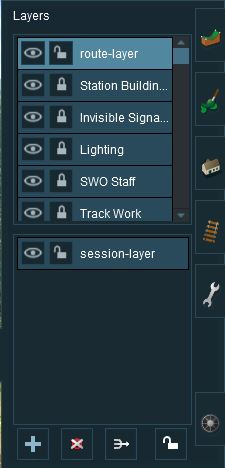 |
 |
The first image on the left gives an example of the layers that can appear if a Route only is loaded into Surveyor. These are the layers that are saved with the Route. Note that a default "session-layer" is present.
The second image on the left gives an example of the layers that can appear if a Session based on that Route is loaded into Surveyor. It shows Route Layers and Session Layers. In both cases, the Route Layers are identical because the same Route has been loaded. A Session contains its own layers, the Session Layers, that are loaded and saved with the Session but are not loaded or saved with the Route.
|
|
Creating a New Route
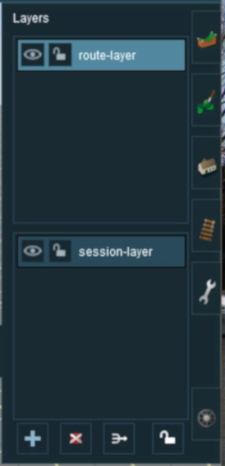 |
|
|||||||||
The "Active Layer"
| In Summary: | |
| The Active Layer is the selected (highlighted) layer. | |
| When you load the Route only into Surveyor, the first Route layer will be the Active Layer | |
| When you load a Session into Surveyor, the first Session layer will be the Active Layer | |
In the image above, the route-layer is the Active Layer. You can change the Active Layer at any time by clicking on the name of another layer.
|
|
Adding a New Layer
| Click the Add Button |
An Add layer dialogue window will appear.
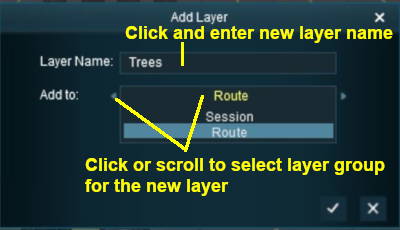 |
|
|||||||||
Deleting a Layer
|
| Select the layer to be deleted and click the Delete Button. If you don't select a layer to delete then Trainz will select the current Active Layer. |
|
If the layer being deleted is empty, then the following dialogue window will appear:-
 |
|
||||||
If the layer being deleted is NOT empty, then the following dialogue window will appear:-
 |
| ||||
|
|
|||||
Merging Layers
|
| Select the layer to be merged into another layer and click the Merge Button. If you don't select a layer to merge then Trainz will select the current Active Layer. |
| In Summary: | |
| Merging a layer into another layer will move ALL the objects from the first layer into the second layer. The first layer, which is now empty, will then be deleted. | |
| Once layers have been merged they cannot be separated. | |
|
The layer merge dialogue window will appear as shown below:-
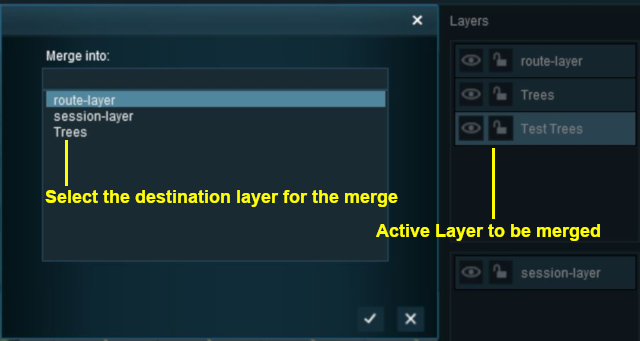 |
|
||||||
Locking Layers
|
| If you LOCK or UNLOCK a Route Layer while editing a Session then you will have made a change to the Route and will be asked to save both the Route and the Session when you exit Surveyor. |
Locking Individual Layers
To LOCK an individual layer, click on the Open Padlock icon next to its name. The layer being locked does not have to be the current Active Layer.
| The objects in a LOCKED layer cannot be moved (around the layout) or deleted but they can be moved to other layers. |
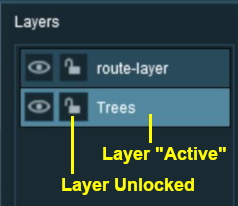 |
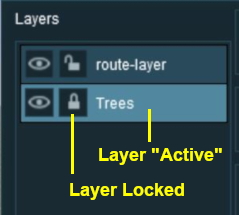 |
|
If you attempt to add a scenery object to a locked layer you will receive the following message:-

|
Locking ALL Route Layers
| Click the Lock Button |
This will LOCK ALL the layers in the Route Layers Group. The Session Layers Group will not be affected.
The Route Layers Group can be UNLOCKED by clicking the Lock Button again.
Moving a Layer
| Main Points: | |
Layers can be moved up or down
|
|
| A layer containing track objects (e.g. signals, switches, etc) CANNOT be placed above the layer containing the track | |
|
In the example shown below a layer created in the Route Layers Group is being moved into the Session Layers Group.
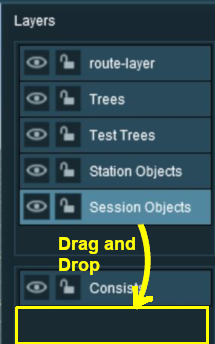 |
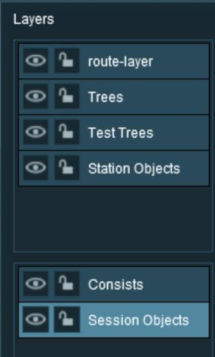 |
|
||||||||||
Hiding Layers
To hide or show a layer click the Eye Icon next to its name.
 |
|
|||||
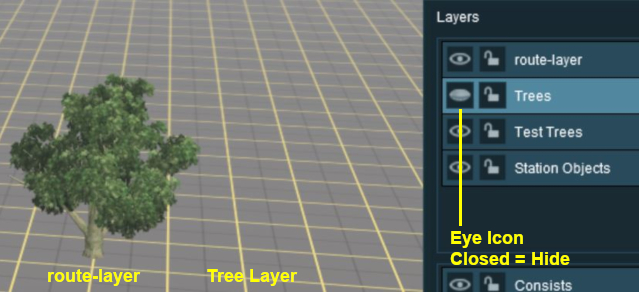 |
|
The Layers Palette in Surveyor 2.0 (S20)
In Surveyor 2.0 (S20), currently only available to Trainz Plus Subscription holders, the Layers are found in the Layers Palette. The palettes are displayed (or hidden) from the Surveyor Windows Menu.
 |
If no Layers Palette is shown on the screen then open the Windows Menu. Every available palette is listed.
Click on a palette name to toggle its state between visible and hidden.
|
Lock the Route Layer Group
All the layers in the Route Layer Group can be locked against accidental alteration.
The Route Layer Group has a padlock icon next to its name - shown as ![]() (unlocked). Left click on this icon to lock ALL the layers in the Route Layer Group. The icon will change to
(unlocked). Left click on this icon to lock ALL the layers in the Route Layer Group. The icon will change to ![]() (locked) - click again to unlock all its layers.
(locked) - click again to unlock all its layers.
Open a Layer Group
To the left of each Layer Group name is a small arrow. Left click on the arrow to open up the group.
 |
The image on the left shows that the Session Layers Group is open and its individual layers are now displayed. To close the group Left click on the arrow again. The image shows that the Session Layers Group contains 3 individual layers:-
|
Renaming a Layer
 |
Right click on a layer name and select Rename Layer.. from the popup menu. You will be asked to enter a new name for the layer. |
Deleting a Layer
 |
Right click on a layer name and select Delete Layer from the popup menu. You will be given a warning that you are about to delete a layer.
|
Moving a Layer
Layers can be individually moved up and down within the same layer group or between the Route Layers Group and the Session Layers Group.
|
Left click on a layer name and, while holding the left button down, drag the layer up or down to its new position.
- depending on the contents of the layer, the process may take some time. You will be shown a progress bar during the move operation
- the move can be reversed (after it has completed) by using the Ctrl Z option
Merging a Layer
 |
Right click on a layer name and select Merge Layer Up from the popup menu.
|
Hiding Layers
Each individual layer has an Eye icon that controls the state (visible or hidden) of that layer. Left click on the icon to toggle its state between visible and hidden.
If the Eye is:-
 open then layer is visible in both Surveyor and Driver
open then layer is visible in both Surveyor and Driver
 closed then layer is hidden in both Surveyor and Driver
closed then layer is hidden in both Surveyor and Driver
Locking Layers
Each individual layer has a Padlock icon that controls the state (locked or unlocked) of that layer. Left click on the icon to toggle its state between locked and unlocked.
If the Padlock is:-
 open then the layer is unlocked and can be edited
open then the layer is unlocked and can be edited
 closed then the layer is locked and cannot be edited
closed then the layer is locked and cannot be edited
|
Setting the Active Layer
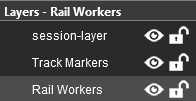 |
the Active Layer is the layer where new objects will be automatically added when using the Placement Tool. The active layer is shown with its name on a blue background. In the image on the left the Rail Workers layer is the current Active Layer. The name of the current Active Layer is also shown in the Layer Palette Title Bar. To set a new Active Layer, Double Left click on a layer name. |
Move an Object to a New Layer
| The Info Palette will show the layer assigned to the currently selected object. To the left of the layer name is a small arrow object. | |||||||
|
|
|
||||||
Route Layers vs Session Layers
This topic has filled endless threads in the Trainz Forums with arguments raging on both sides.
| In Summary: | |
| In general, there are no "cast iron" rules that dictate what should be placed in the Route Layers Group and what should be placed in the Session Layers Group (for an exception see TRS19 Platinum Edition, Trainz Plus, TRS22 Notes below). Each Route and Session will be different and different creators have different ways of working. The main question to be asked is how many different Sessions will be created using a particular Route? | |
Notes:
|
TRS19 Platinum Edition, Trainz Plus, TRS22 Notes:
|
The Route Layers Group
| The Route Layer Group should be used for everything that will always appear in Driver Mode regardless of which Session is playing. |
There is nothing stopping you from placing everything in the "route-layer" of the Route Layers Group and never having to worry about dealing with layers ever again - some creators prefer to work this way. However, layers do provide you with a way of organising your scenery objects to make them more manageable, particularly in more complicated layouts. Some examples:-
- A Special Objects layer or layers that can be used to hold certain scenery objects. For example all the trees or a particular building. This can be very useful when you need to hide those objects to locate or place other objects. Trackside cameras in particular can be very difficult to find when placed in a forest.
- A Platform Objects layer can be used to hold all platform items such as seats, luggage, luggage trolleys, people, lamp posts, etc. Because these items are placed on top of a platform object they can be very difficult to move or delete without first moving the platform. The layer containing the platform can be locked allowing these objects to be easily moved or deleted.
- Hiding and Showing Objects in Driver Mode. There is a Session Rule and a Driver Command that can hide and show layers during the running of a Session. For example: a rail worker can be placed in a separate layer and positioned next to a track lever while shunting operations are underway but can be removed from the scene by hiding that layer when shunting has been completed.
- A Test Layer for experimenting. Not sure if a particular object is right for your layout? Place it in a temporary layer which you can hide and show to see any differences it makes. This is particularly useful if you are deciding between different types of grasses, for example, placed throughout the layout. If the objects prove to be unsuitable then they can all be deleted by deleting the layer. If they are suitable then the layer can be merged with another or left as a new layer.
- A Ruler Layer if you are using rulers. Although rulers obey layer behavior (lock and hide) just like all other objects and splines, they have no properties window to show their layer or allow you to change that layer. Consider placing all rulers in a dedicated layer to make their management easier. NOTE: Due to a bug in TANE/TRS19, deleting a dedicated Ruler Layer will not delete the rulers but will temporarily hide them from view. Rulers will still have to be deleted individually.
|
The "route-layer"
| To avoid any confusion over which layer is the original "route-layer", this is one layer that should not be renamed or moved from the top position. |
While all layers are equal, the "route-layer" is special.
|
|
The Session Layers Group
| The Session Layers Group should be used for everything that will only be seen in the currently loaded Session. |
If you are creating more than one Session based around a particular Route, then you will probably make use of the Session Layers.
| Notes: Session Layers can contain:-
|
||||
|
||||
Adding Objects To Layers in S10
When an object (such as a scenery item, consist, track or track object) is added to the layout it is automatically placed in the currently Active Layer. Unfortunately, Surveyor Classic (S10) does not indicate which layer is the Active Layer unless you open the Layers Tool to look. This can lead to objects being placed into the wrong layers and while these objects can later be moved to another layer (see the section Moving Objects To Other Layers below) it would be better to correctly set the Active Layer first.
|
| You cannot add objects to a layer that is LOCKED. |
If you attempt to add a scenery object to a locked layer you will receive the following message:-

|
| When adding track objects (signals, speed signs, etc) to a track, the objects being added must be in the same layer as the track or in a layer below the track layer. For more information, see the section |
|
Deleting Objects From Layers
|
| You cannot delete objects from a layer that is LOCKED. |
Unfortunately Trainz does not give you a warning message when you attempt to delete an object from a locked layer, the object just refuses to be deleted.
|
Moving Objects To Other Layers
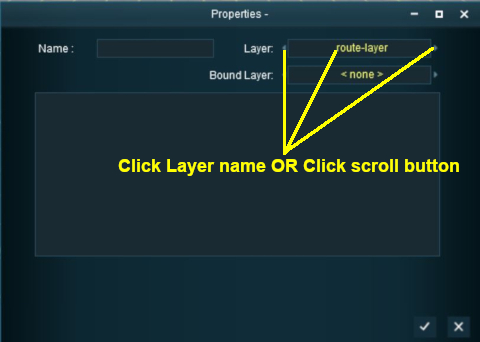 |
|
||||||||||
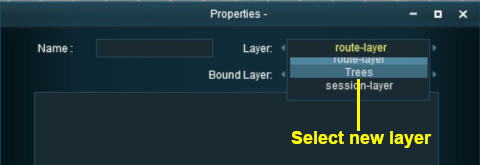 |
|||||||||||
The Bound Layer
This is a little used and probably little understood layer feature. It allows you to attach an object to two different layers so it can have the properties (locked/unlocked and show/hide) of both layers. The bound layer was introduced as a development tool, its sole use is as a tool in the building of routes and sessions.
| An object will be LOCKED and cannot be deleted or moved if its layer OR its bound layer is locked. | |
| An object will be HIDDEN if its layer OR its bound layer is hidden. | |
| Rulers cannot be bound to another layer. |
Some applications:-
- Temporarily locking an object by binding it to a locked layer while allowing other objects in the same unlocked layer to be moved or deleted. A simple but very effective development technique is to create a Route layer called "Locked" and then lock it. If you need to temporarily stop an object from being deleted or moved then it can be bound to the "Locked" layer.
- Temporarily hiding an object by binding it to a hidden layer (this will require the hidden layer to be made visible so the object can be unbound).
 |
|
||||||
| When a layer is deleted any objects bound to that layer will have their Bound Layer reset to <none> |
|
|
Layers in Driver Mode
During the running of a Session in Driver Mode visible layers can be hidden and invisible layers revealled according to the events that occur during the Session.
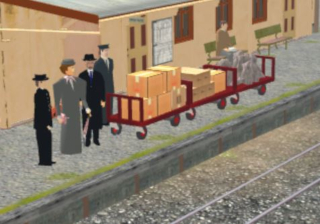 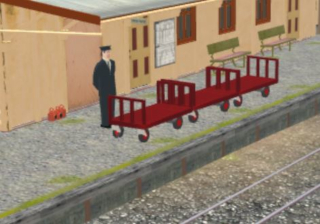 |
The two Driver Mode scenes shown on the left illustrate this feature.
|
This effect could be achieved in two different ways:-
- A Driver Command - specific to a particular driver, or
- A Session Rule - specific to a particular driver, consist, or any driver/consist
Using a Driver Command
The driver command Layer Control hides and shows named layers.
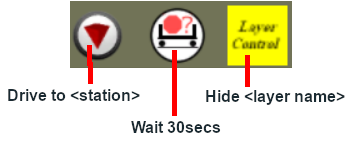
Using Session Rules
 |
Rules Used: |
- Trackside Check Rule - to trigger the event
- Show/Hide Layer Rule - to hide layers
- Message Popup Rule - to open a browser window with a message
 |
Session Editor Screenshot: |
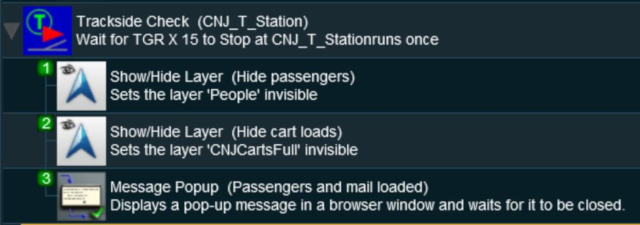 |
 |
Description: |
In this example:-
- The Trackside Check Rule is triggered when a specific train comes to a stop at a trackmark. This then executes the following rules in order:-
- The Show/Hide Layer Rule is used to hide the layer named "People". Four passengers (three standing and one seated) are hidden.
- The Show/Hide Layer Rule is used to hide the layer named "CNJCartsFull". The boxes and mail bags on the three platform trolleys are hidden.
- The Message Popup Rule is used to place a message on the screen informing the player that the passengers and mail have been loaded.
Trainz Wiki
 |
More Tutorials and Guides to Using Trainz |
This page was created by Trainz user pware in June 2018 and was last updated as shown below.
